|
Other
Lansing Companies that contributed to winning World War Two
Motor
Wheel Corporation in World War Two

Recognizing a Company
from my Hometown that contributed to winning World War Two
1920-1996 Lansing, MI
Goodyear purchased in 1964
1984-Current as Motor Wheel in Chattanooga, TN
This page updated
11-6-2023.
The Motor Wheel Mark of
Quality sign above came from the former Motor Wheel cafeteria. It
is now at the R.E. Olds Transportation Museum in Lansing, MI.
Motor Wheel was formed in
1920 through the merger of five different companies. These were Prudden Wheel, Gier
Pressed Steel Company, Auto Wheel Company, and Wies & Leah Manufacturing
Company. Between 1920 and 1942, Motor Wheel produced 87 million
wheels for the American Automobile Industry. These were enough
wheels to equip 17,000,000 vehicles with five wheels each. During this
period, Motor Wheel was the world's largest producer of automotive
wheels and had one third of the American market.
In 1932, Motor Wheel began
producing brake drums using the newly developed centrifugal casting
method developed by the Campbell, Wyant, and Cannon Foundry in Muskegon,
MI. Motor Wheel was the exclusive user of the brake drums produced
by the new casting method. In 1937 Motor Wheel built a
foundry near its plants on the north side of Lansing and leased the
facility to the Campbell, Wyant, and Cannon Foundry, which changed its
name to Centrifugal Fusing. Between 1932 and 1948, Motor Wheel
produced 48,000,000 brake drums using the centrifugal casting method.
After World War Two Motor Wheel purchased Centrifugal Fusing. In
1964 Goodyear purchased Motor Wheel.
The company still exists
today in Chattanooga, TN and produces heavy duty brake drums with the
centrifugal casting method. In 1984, the brake drum operation of
Motor Wheel Corporation moved to Chattanooga, TN. In 1996 the
remaining wheel making operations in Lansing, MI closed down. The
Motor Wheel name currently continues today and produces heavy duty brake drums with
the centrifugal casting method.
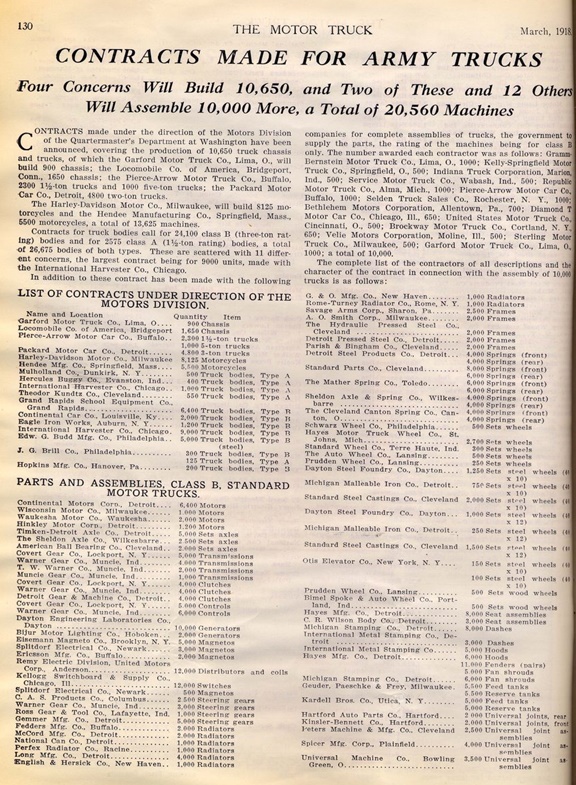
During World War One, Auto Wheel
Company
was contracted to produce 500 sets of wheels for the Class B, Standard Motor Truck,
more commonly known as the Liberty Truck.
The Prudden Wheel Company was contracted to produce another 250 sets of
wheels and 500 sets of wooden wheels for that vehicle. In 1919 the
two companies would merge with two other companies to become the Motor
Wheel Corporation. Document
courtesy of Warren Richardson.
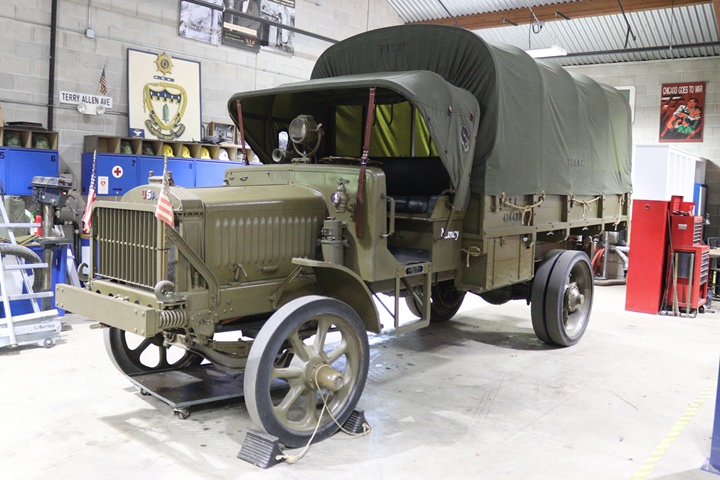
This World War One Class B Liberty Truck has
been restored to operating condition by the First Division Museum in
Wheaton, IL. Author's photo.
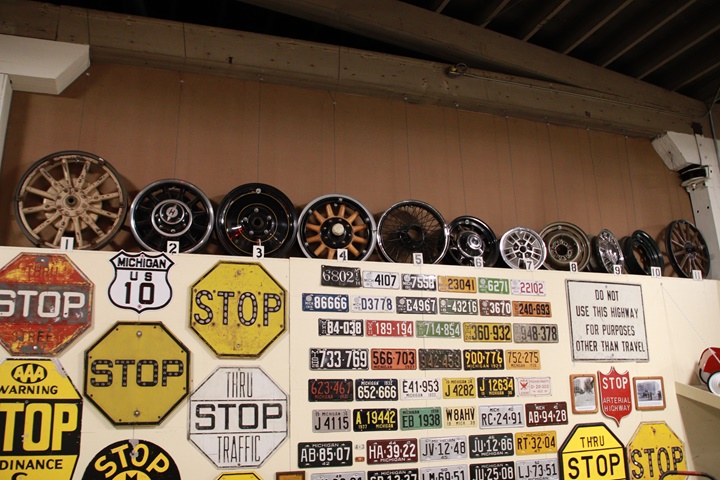
This and the next two photos are a collection
of wheels produced by Motor Wheel that are on display at the R.E. Olds
Transportation Museum. The collection shows a wide
variety of wheels that the company produced while in Lansing.
Originally, Motor Wheel manufactured wooden wheels before the technology
for metal wheels was developed. Author's photo.
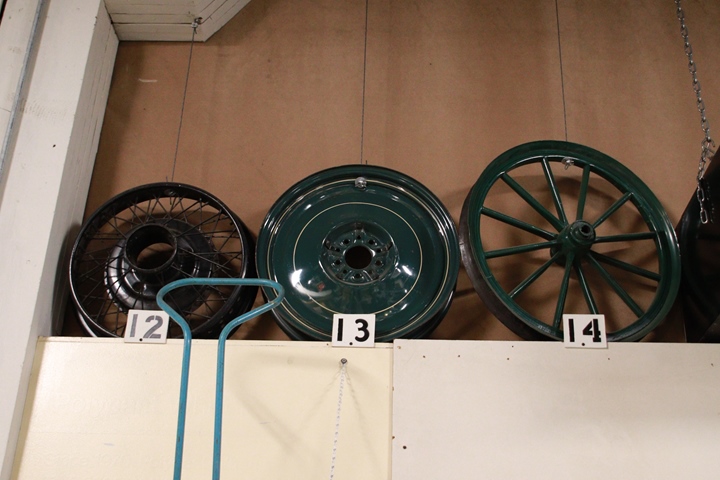
Author's photo.
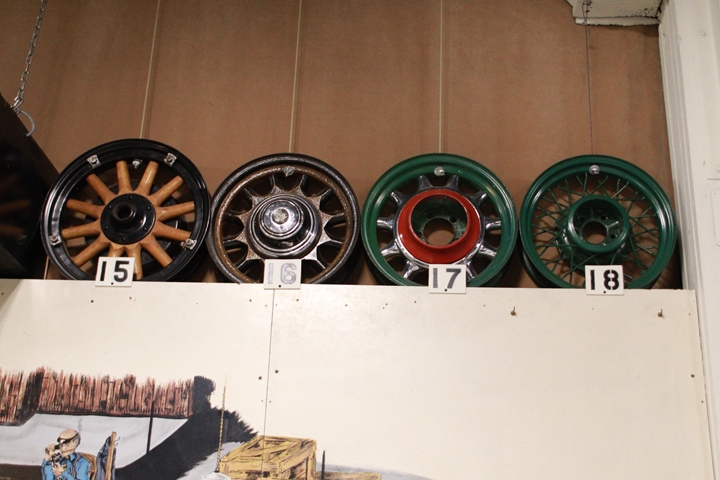
Author's photo.
From almost the start of this website in 2013,
Motor Wheel was on my list of companies for which I wanted to do a page.
However, I was not able to find very much information on what the
company produced during World War Two. There was not enough
information to
author what I thought was needed to present an adequate history of the
company during this important period in the nation's history. In
early July 2021, I was able to discover slightly more information on
Motor Wheel in World War Two. The additional
information was enough to do a page on the company, but it would still
not have the depth of information I was really seeking to tell the true
and entire story of Motor Wheel during World War Two. This would
all change in early September 2021 as I visited Lansing, MI, and one of
my stops was the R.E. Olds Transportation Museum.
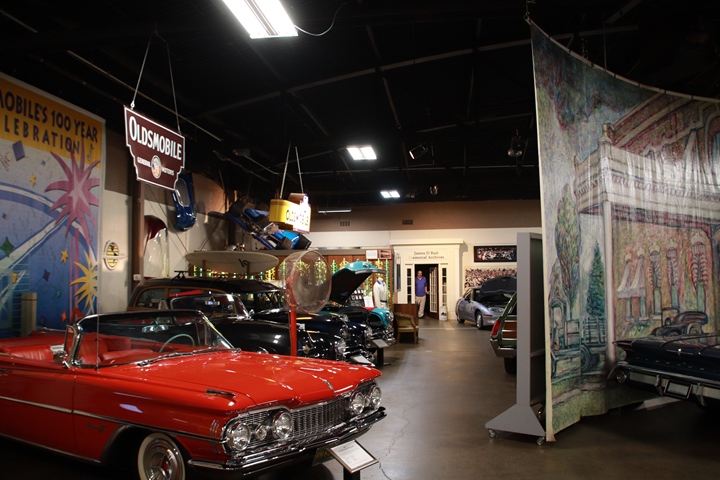
My primary purpose for visiting the Olds
Museum was to photograph the actual building, as I had discovered it was
the same building that the Hill Diesel Company occupied during its
existence in Lansing. The classic "being in the right place at the
right time" would allow me to find enough information to write this
page. While taking this photo, I noticed a museum employee exiting
the museum archives. In previous trips I had not even noticed the
entrance to the archives. I asked the employee if he was the
archivist, to which he answered "Yes." I then asked him if the
archives had any information on the history of Motor Wheel in World War
Two, to which he replied in the affirmative, and told me to follow him
into the archive area.
The R.E. Olds Transportation Museum had just
recently acquired a complete set of the "Motor Wheel News," the
company's employee newsletter for the years 1940-1945. The
newsletters had enough information on Motor Wheel's World War Two
products to allow me to now produce a page on the company and its
contribution to winning World War Two. All by being at the
right place at the right time.
Since I started this website in 2013, I have
looked at several company newsletters from World War Two.
Normally, only about 1% of the content of these newsletters address the
information I am seeking. Also, due to wartime censorship
restrictions, production numbers were not allowed to be published by
companies during the war, as
enemy agents could use it to determine the war production capacity of the country.
Also, in the particular case of the "Motor Wheel News," many of the
articles about its war products were somewhat vague. But I think I have been able
to find enough information to tell how the Motor Wheel Corporation was
an important manufacturer of products that helped win World War Two.
I want to thank Mr. Rick Kaiser, Operations
Manager for the R.E. Olds Transportation Museum, for spending over an
hour with me in researching Motor Wheel and several other Lansing
companies during my visit to the museum in September 2021. I
highly recommend this museum to anyone visiting Lansing, MI. This
is a first class museum.
Motor Wheel Corporation won the Army-Navy "E"
Award five times during World War Two.
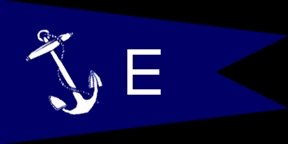
On March 9, 1942 the U.S. Navy congratulated
Motor Wheel for its production of one million 40mm shell casings.
The U.S. Navy had only expected Motor Wheel to complete half of that
amount by that date. For this, Motor Wheel was awarded the
Navy "E" Award on June 9, 1942.
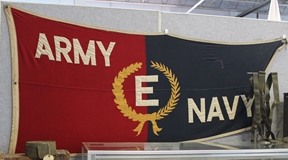
On August 15, 1942 Motor Wheel replaced its
Navy "E" flag with the Army-Navy "E" flag as companies were allowed to
do.
Motor Wheel Corporation won its second Army-Navy "E" Award on November
15, 1942.
Motor Wheel Corporation won its third Army-Navy "E" Award on May 15,
1943.
Motor Wheel Corporation won its fourth Army-Navy "E" Award on December 10,
1943.
Motor Wheel Corporation won its fifth Army-Navy "E" Award on February 1,
1945.
Motor Wheel World War Two Production: Motor Wheel was
highly diversified in its products during World War Two. While the
company manufactured wheels for both trucks and tanks, it built many
other military products to help win World War Two. In 1941, Motor
Wheel received its first military contract for three-inch anti-aircraft
projectiles. By the end of November 1941, Motor Wheel was awarded
three other military contracts. One was from the Army for 400,000
75mm semi-armor piercing projectiles. The U.S. Navy also contracted the
company for three-inch anti-aircraft projectiles. This made
economic sense, as Motor Wheel was already producing this type of projectile for
the Army. Motor Wheel also contracted with the Navy for brass 40mm
shell casings for which it was already noted that it won the U.S. Navy
"E" award in June 1942. The company was also sub-contracting
other military products to
other manufacturers at this time.
These were the first of many contracts and a multitude of products Motor
Wheel would build during the war.
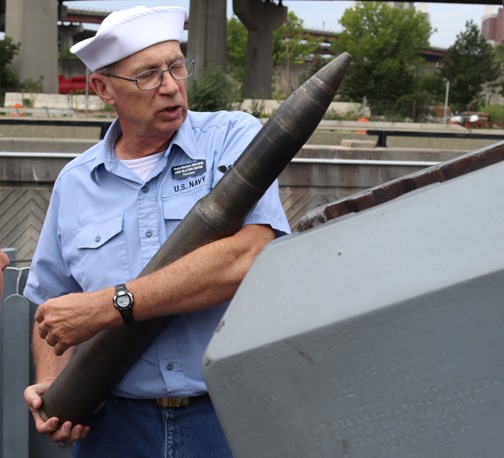
This docent on the destroyer escort USS
Slater is showing the tour group how a three-inch anti-aircraft
projectile would be loaded into one of the ship's three-inch dual
purpose guns. This photo shows the size of the type of shell Motor
Wheel was producing in late 1941. Author's photo.
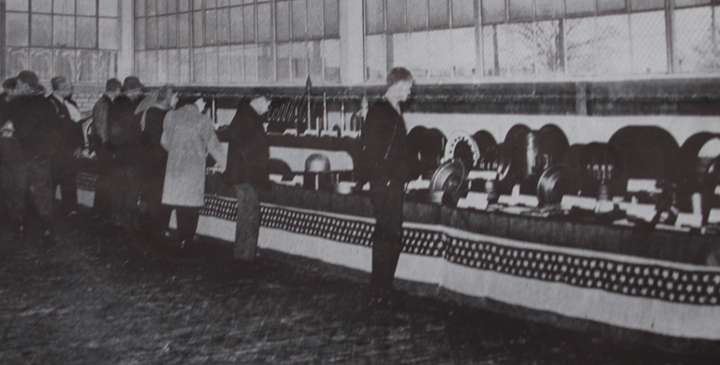
This photo from the December 15, 1944 issue
of "Motor Wheel News" shows a long display table with components the
company was producing for the war effort. The related article
described the individual items. The next three paragraphs are a
direct quote from the "Motor Wheel News" that describe the contents of
the display. These three paragraphs are the most extensive listing
of Motor Wheel Corporation products made during World War Two.
"Supply truck wheels, combat wheels for "ducks," combat wheels for tank
destroyers, combat spiders, Centrifugal brake drums for fighters,
three-inch high explosive projectiles, 40mm gun casings, 75mm armor
piercing shot, implement discs, driver discs for M18 Hellcat tank
destroyers, idler wheels for M4 Sherman tanks, road wheels for Hellcats,
amphibian wheels for "alligators."
Bogie wheels and hubs for M4 Sherman tanks,
propeller domes for fighters and bombers, fuse seat liners, rockets and
motors, 40mm armor piercing cartridge cases, three-inch anti-aircraft
projectiles, three-inch 50 cal. H.V. projectiles, three-inch semi-armor
piercing projectiles, dolly wheels for trailers, torpedo fuel tanks,
hemisphere bomb noses, 57mm T4 containers, cylinder head covers, body
rim guards for aerial bombs, sleeve bearing retainers for "ducks."
Aeroplane brackets, Centrifugal brake drums
for Superfortresses and Flying Fortresses, spacers for amphibian "ducks,"
brake drums for trucks, spider plates for machine gun mounts, hubs for
155mm gun mounts, hubs and drums for 105mm gun mounts, tractor wheels."
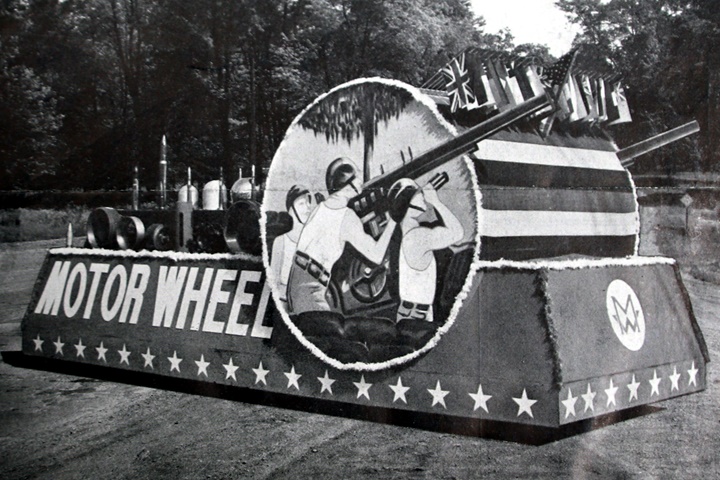
This parade float shows what appears to be
armored vehicle road wheels and an idler wheel. Behind the wheels
are several types of shells. In the middle are several cylinders. The cylinders have rounded
tops welded to them and are for an unknown product.
For wheels and brake drums, production numbers
shown in the next section are for only OEM
production. Both products, especially brake drums, would have
needed a constant supply of spare parts. Brake drums throughout
the life of both trucks and aircraft would have been replaced many
times.
As I noted above, for many years I was unable
to find any information on Motor Wheel in World War Two until September
2021 when I gained access the Motor Wheel letters. In early 2022,
I became aware of available information on major war contracts issued by
U.S. Government agencies during World War Two. In the case of
Motor Wheel, these were the U.S. Army and the U.S. Navy, and their
contracts are listed in the table below. The information in the
table supports the narrative and information from the newsletters and
adds dollar amounts and the dates of the contracts. Shells, shot,
cartridge cases, and rocket bodies were main types of products supplied
to the Army and Navy by Motor Wheel. The total of all of the
contracts was $87,320,000.
Motor Wheel Corporation's Major World War Two Contracts
The information below
comes from the "Alphabetical Listing of Major War Supply
Contracts, June 1940 through September 1945." This was
published by the Civilian Production Administration,
Industrial Statistics Division. Table added 4-5-2022. |
|
Product - Customer |
Contract Amount |
Contract Awarded
|
Completion
Date |
|
Shells - Army |
$71,000 |
7-1940 |
5-1941 |
|
Shells - Army |
$308,000 |
3-1941 |
8-1941 |
|
Forgings - Projectiles - Navy |
$6,320,000 |
6-1941 |
7-1942 |
|
Shells - Army |
$229,000 |
7-1941 |
10-1941 |
|
Cartridge Cases - Navy |
$6,889,000 |
9-1941 |
11-1942 |
|
Shells - Army |
$231,000 |
11-1941 |
1-1942 |
|
Shot - Army |
$1,291,000 |
11-1941 |
7-1942 |
|
Shells - Army |
$308,000 |
1-1942 |
7-1942 |
|
Material Ordnance - Navy |
$7,264,000 |
2-1942 |
7-1943 |
|
Shot - Army |
$958,000 |
2-1942 |
9-1943 |
|
Shells - Army |
$647,000 |
3-1942 |
1-1943 |
|
Shot - Army |
$604,000 |
5-1942 |
12-1942 |
| Ordnance
Equipment - Navy |
$10,927,000 |
6-1942 |
7-1944 |
|
Shell Machining HE3 - Army |
$2,888,000 |
6-1942 |
10-1944 |
|
Shells - Army |
$978,000 |
7-1942 |
6-1943 |
|
Shot - Army |
$4,883,000 |
9-1942 |
5-1944 |
|
Shot - Army |
$1,122,000 |
10-1942 |
3-1943 |
|
Shot - Army |
$1,122,000 |
10-1942 |
3-1943 |
|
Shells - Army |
$573,000 |
12-1942 |
1-1943 |
|
Cases Cartridge - Navy |
$9,920,000 |
3-1943 |
2-1944 |
|
Bomb Parts - Navy |
$1,290,000 |
4-1943 |
7-1944 |
|
Cartridge Cases - Navy |
$8,171,000 |
6-1943 |
9-1944 |
|
Projectiles AA - Navy |
$2,417,000 |
8-1943 |
6-1944 |
|
Waterproof Gun Covers - Navy |
$280,000 |
9-1943 |
6-1944 |
|
Dummy Nose Plugs - Navy |
$57,000 |
1-1944 |
8-1944 |
|
Rockets MK 10 - Navy |
$1,003,000 |
3-1944 |
3-1945 |
|
Metal Containers T4 - Army |
$354,000 |
3-1944 |
6-1944 |
|
Protecting Caps - Navy |
$366,000 |
5-1944 |
1-1945 |
|
Wheels Spacers - Army |
$3,829,000 |
5-1944 |
12-1945 |
|
Projectiles AA - Navy |
$1,740,000 |
6-1944 |
2-1945 |
|
Cart Cases 40mm MK 2 - Navy |
$6,488,000 |
8-1944 |
4-1945 |
|
Protecting Caps MK 3 - Navy |
$490,000 |
9-1944 |
1-1946 |
|
Rocket Bodies - Navy |
$628,000 |
9-1944 |
4-1945 |
|
Projectiles - AA MK 31 - Navy |
$1,234,000 |
11-1944 |
7-1945 |
|
Rocket Bodies - MK 10 - Navy |
$606,000 |
2-1945 |
1-1946 |
|
Rocket Bodies - MK 10 - Navy |
$513,000 |
4-1945 |
2-1946 |
|
Projectiles - Navy |
$65,000 |
7-1945 |
12-1945 |
|
Amm Protecting Caps - Navy |
$346,000 |
7-1945 |
6-1946 |
|
Total |
$87,320,000 |
|
|
Motor Vehicle Wheels: Motor Wheel
was the supplier for the wheels on the most produced and famous American
truck of World War Two, the GMC CCKW 2-1/2-ton 6x6 truck. It also
furnished the wheels for GMC DUKW and the Studebaker US6 2-1/2-ton 6x6
truck. It produced many of the road and idler wheels for the M4 Sherman tank
series and for the M18 Hellcat tank destroyer. It was the
exclusive supplier of road wheels, return wheels, and idler wheels for
the M26 Pershing tank. Motor Wheel was an important supplier of
these products for the war effort.
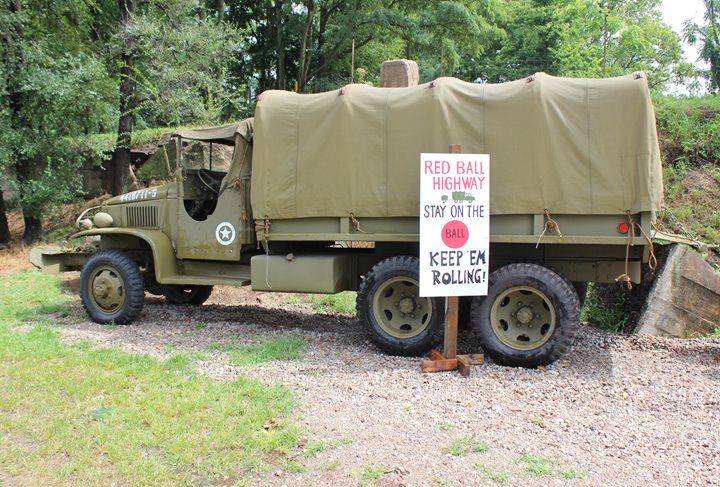
This is the classic GMC 2-1/2-ton 6x6 truck
and is the long wheelbase version CCKW-353. Author's photo.
For the United States,
World War Two was the first completely mechanized war. There were
tanks, jeeps, tanks, armored cars, tank destroyers, halftracks, and
trucks that were used by the U.S. military. They came in all sizes from the 1/4-ton
4x4 Jeep to the 10-ton wrecker. But there is one truck that
comes to a person's mind when thinking or thinking of a trucks from World
War Two, and it is the GMC 2-1/2-ton 6X6. It is the definitive
truck of World War Two!
A Notable Quote from "The Great Crusade" by General
Dwight D. Eisenhower: "Incidentally, four other pieces of
equipment that most senior officers came to regard as among the most
vital to our success in Africa and Europe were the bulldozer, the jeep,
the 2-1/2-ton truck, and the C-47 airplane."
For the United States Army in Africa and Europe, the 2-1/2-ton truck
General Eisenhower refers to is the GMC CCKW. The CCKW was
exclusively used by the Army as the Studebaker version went to Great
Britain and Russia, and the International Harvester version was also
sent overseas on Lend-Lease, or were used by the U.S. Marines and Navy.
The Motor Wheel Corporation part number for
the CCKW series 20x7 wheel was 82023.
GMC
World War Two Trucks Accepted by Detroit Ordnance, US Army
The information below comes from "Summary Report of
Acceptances, Tank-Automotive Material, 1940-1945"
Published by Army Services Forces, Office, Chief of
Ordnance-Detroit, Production Division, Requirements and
Progress Branch
January 21, 1946. |
|
Type |
1940 |
1941 |
1942 |
1943 |
1944 |
1945 |
Total |
| CCW-353 |
0 |
707 |
22,687 |
255 |
0 |
0 |
23,649 |
| CCKW-352 |
244 |
20,372 |
22,657 |
9,325 |
954 |
440 |
53,992 |
| CCKW-353 |
7,929 |
30,424 |
88,329 |
121,518 |
125,732 |
89,717 |
463,649 |
| AFKWX-353 |
0 |
0 |
613 |
1,619 |
4,000 |
1,000 |
7,232 |
|
Total |
8,173 |
51,503 |
134,286 |
132,717 |
130,686 |
91,157 |
548,522 |
Number of Motor Wheel Corporation Wheels made for the GMC
CCW, CCKW-352, CCKW-353, and AFKWX-353 Trucks
|
|
Type |
1940 |
1941 |
1942 |
1943 |
1944 |
1945 |
Total |
| CCW-353 - 11
Wheels per Truck |
0 |
7,777 |
249,557 |
2,805 |
0 |
0 |
260,139 |
| CCKW-352
- 12 Wheels per Truck |
2,928 |
244,464 |
271,884 |
111,900 |
11,448 |
5,280 |
647,904 |
| CCKW-353
- 11 Wheels per Truck |
87,219 |
334,664 |
971,619 |
1,336,698 |
1,383,052 |
986,887 |
5,100,139 |
| AFKWX-353
- 11 Wheels per Truck |
0 |
0 |
6,743 |
17,809 |
44,000 |
11,000 |
79,552 |
|
Total |
90,147 |
586,905 |
1,499,803 |
1,469,212 |
1,438,500 |
1,003,167 |
6,087,734 |
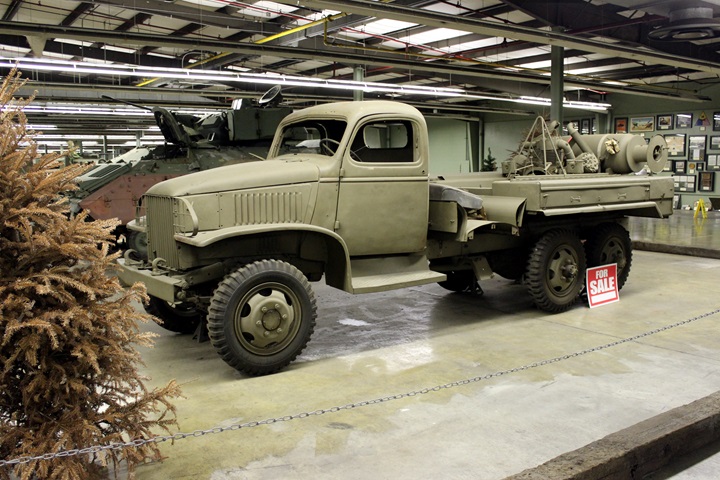
This GMC 1941-1942 CCW-353 6x4 is minus its outer back wheels.
Motor Wheel Corporation supplied 260,139 wheels for this type of truck. This particular
example has a 210 CFM Roi Air Compressor mounted on the bed.
Author's photo.
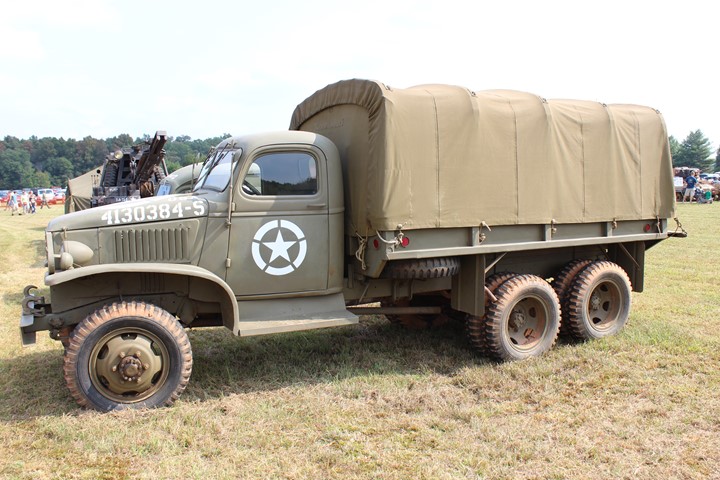
This steel enclosed cab CCKW-353 shows the
location of the spare tire underneath the body of the truck. This
was the supply version of the truck. Motor Wheel manufactured
5,100,139 wheels for the 463,649 long bed CCKW-353. Author's
photo.
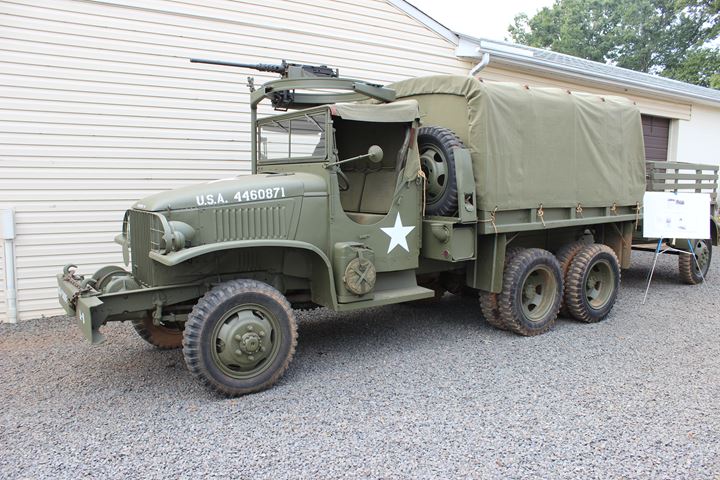
The CCKW-352 was a short bed version of the
truck and was intended to be a prime mover of artillery. Due to the
lack of space underneath the short bed body, the spare tire and fuel
tank were moved between the cab and the body. This movement
allowed for a second spare tire to be placed in this area on the truck.
Therefore, Motor Wheel had to supply twelve wheels for this type of
vehicle. This amounted to 647,904 wheels. Author's photo.
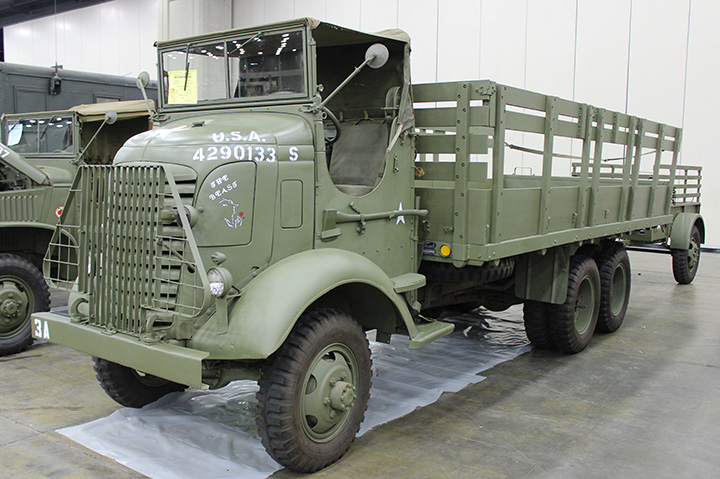
GMC built 7,232
of the AFKWX-353, which was a cab over engine design with a longer cargo
body for transporting bulky loads. It had the same wheel base as
the CCKW-353 and had a 15 or 17 foot body which was three or five feet
longer than the CCKW-353 series truck. Like the CCW-353 and
CCKW-353, the AFKWX-353 had one spare tire underneath the body. It
required eleven tires per vehicle. Motor Wheel Corporation
supplied 79,552 wheels for the AFKWX-353 during World War Two.
Author's photo.
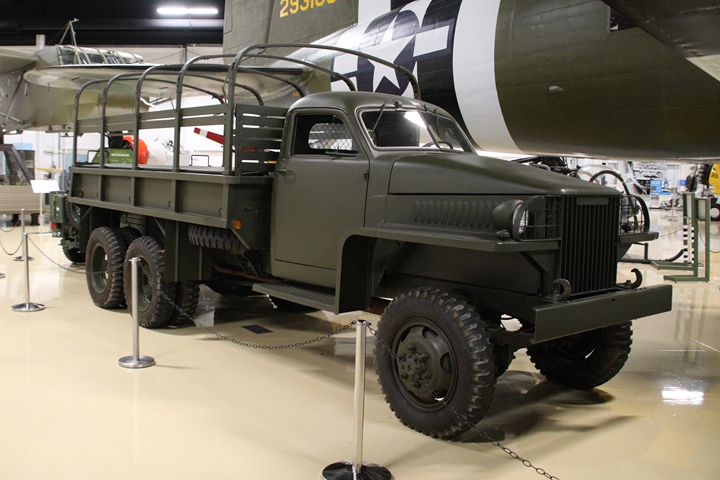
This is the Studebaker US6 2-1/2-ton 6x6
truck which was provided to foreign countries either through direct
purchase or Lend-Lease. In 1941, Motor Wheel supplied brake drums
and hubs for 5,714 US6 trucks destined for Great Britain when the normal
supplier could not furnish these parts. Author's photo.
DUKW: The April 1, 1944, edition
of the "Motor Wheel News" notes that Motor Wheel Corporation supplied
the wheels for the GMC DUKW. The Ordnance Supply Manual shows that
prior to serial number 406, the disk and rim used a Goodyear "L" rim in
GM part number 2182022. For serial numbers starting with 406, a
wheel assembly used a Firestone "CV" rim with GM part number 2182087. It appears that Motor Wheel was a subcontractor to both
of
these companies, supplying wheel components to both Goodyear and
Firestone for use on the DUKW. There were 21,147 DUKWs built
during World War Two. Motor Wheel as a subcontractor supplied
124,882 wheels for this very important vehicle.
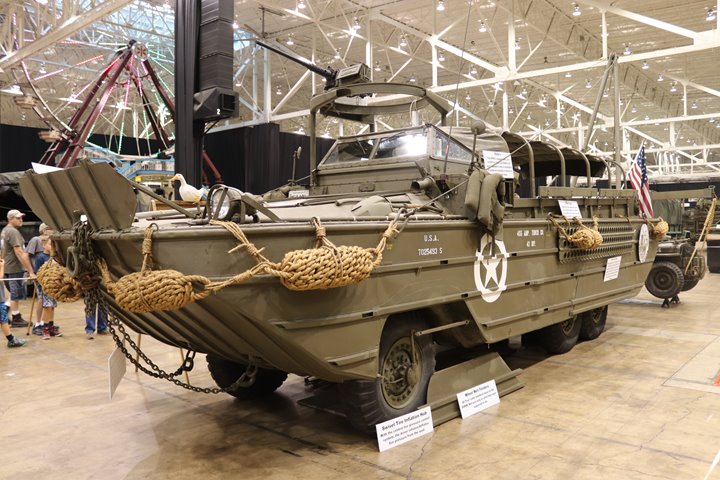
Author's photo added 12-25-2021.
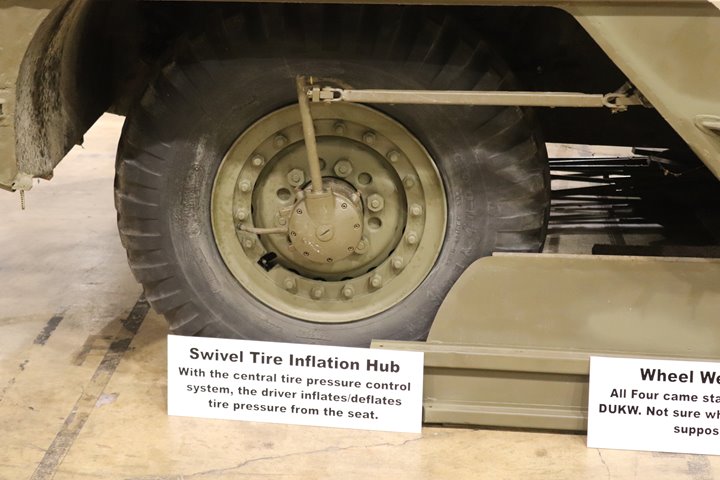
Author's photo added 12-25-2021.
Gun Carriages:
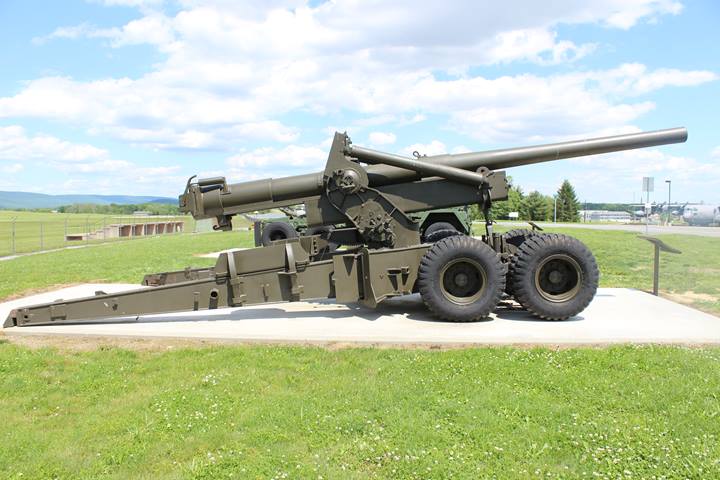
The 155mm "Long Tom" is identified in the
"Motor Wheel News" as having wheels and hubs built by Motor Wheel on the
north side of Lansing, MI. There were 494 155mm cannons produced
during the war. Each carriage had ten wheels indicating Motor
Wheel would have provided 4,940 wheels and hubs for the weapon. Author's photo.
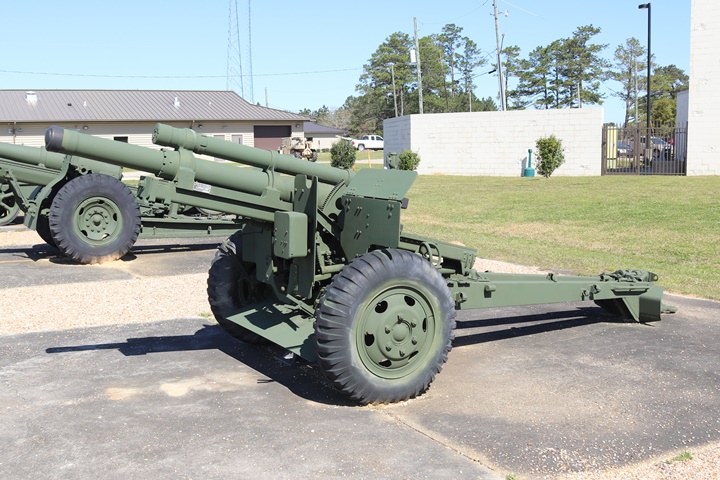
Motor Wheel Corporation supplied hubs and
brake drums for the 8,536 105mm howitzers built in World War Two.
Author's photo added 12-25-2021.
Road, Idler, and Track Return Wheels for Tracked Vehicles:
Author's Note: There were several
different names for the different types of wheels used on World War Two
tracked vehicles. Road wheels were also called boogie wheels.
Sometimes they were also described as disks. The track return
wheels were also described as rollers in some publications.
M4 Sherman Tank Road and Idler Wheels: Motor Wheel
made an undetermined amount of road wheels for the Sherman. There
were six types of road wheels manufactured for the Sherman tank with the Vertical Volute
Suspension System (VVSS). Motor Wheel is documented as
producing what was known as the stamped spoke type. There were
40,661 Sherman tanks produced with VVSS. There were another 13,942
gun motor carriages and other types of vehicles that were built on
Sherman chassis equipped with VVSS. Each vehicle had twelve road
wheels, resulting in at least 655,236 road wheels required for original
equipment. If Motor Wheel built 10% of the Sherman VVSS road wheels,
it would have produced over 65,000.
Motor Wheel was a subcontractor to the final
manufacturer for this product. After the basic metal wheel was
assembled, it needed to go to a rubber tire company which then
vulcanized a rubber tire around the outer diameter of the wheel.
The last step in the process was then installing the bearings in the
unit. Motor Wheel also produced the smaller idler wheel in the
stamped spoke design.
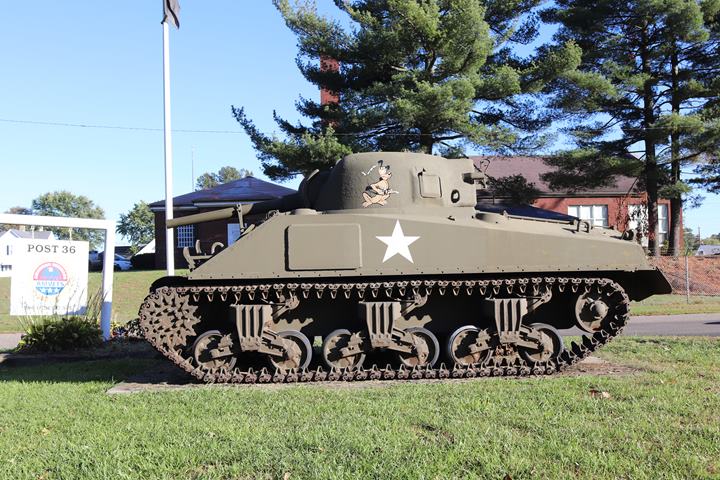
This M4A3(75)VVSS is equipped with stamped spoke road and idler wheels like Motor Wheel
built. Author's photo.
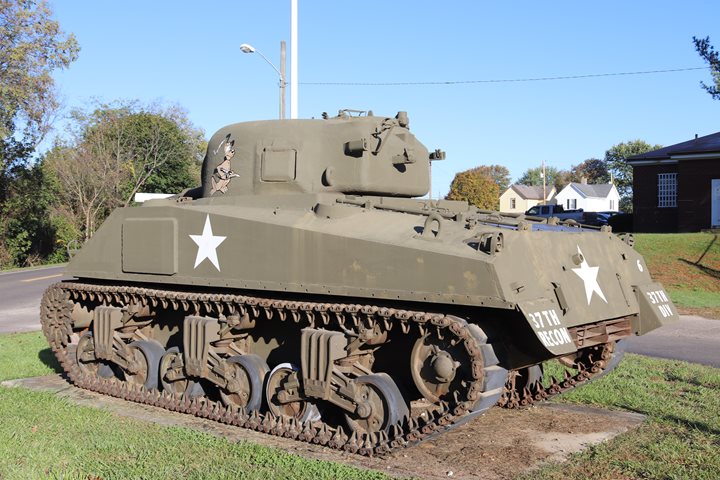
The photo shows the rubber tires were
vulcanized onto the wheel. Motor Wheel only built the basic wheel.
The final supplier of the road and idler wheels installed the bearings,
making them ready for installation onto the tank. A considerable
number of spares were needed for the road wheels, as debris that the tank
ran over in operation caused the rubber wheels to disintegrate during
use. Author's photo.
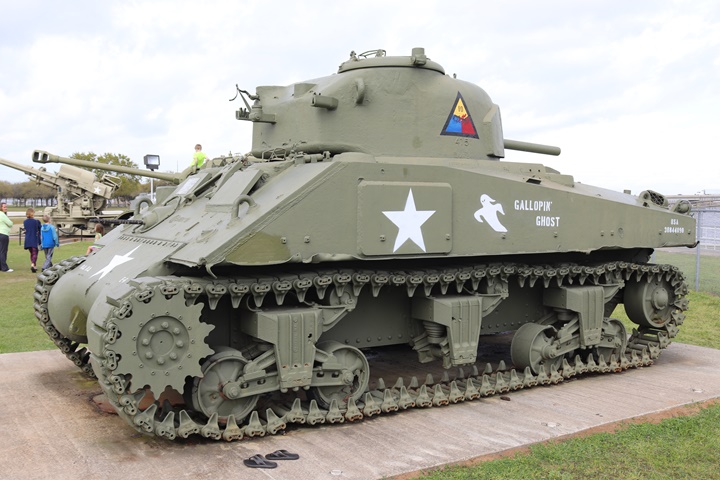
This example of an M4 Sherman tank with VVSS
shows the bare road wheels with no rubber tire. The road wheels
and idler wheel at the rear of the tank are the stamped spoke type that
Motor Wheel manufactured. With the rubber wheels off, this photo
shows the wheel as it came off the Motor Wheel assembly process, minus
the bearings. Author's photo.
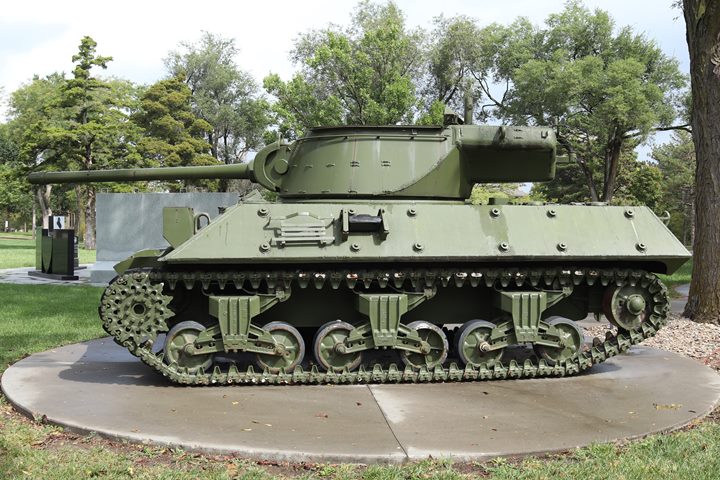
The M36 tank destroyer was converted from
the earlier M10A1 tank destroyer. The three-inch main gun was
replaced with a more powerful 90mm main gun in a new larger turret.
The drive train to the M10A1 and similar M10 used the same Vertical
Volute Suspension System as the Sherman tank. This particular M36
has five of the six road wheels and the idler wheel with stamped spoke
wheels like Motor Wheel made. As the war progressed, it was not unusual to find several different types of road wheels on the Sherman
type vehicles. Damaged road wheels were replaced with whatever was
available, many of the wheels having been salvaged from destroyed
vehicles. Author's photo.
M18 Hellcat Tank Destroyer Road, Idler, and
Return Track Wheels: Motor Wheel was the supplier of the road,
idler, and return track wheels for this Buick-vehicle built in nearby
Flint, MI. There were 2,507 M18 tank destroyers built.
Buick-Built World War Two M18 Tank Destroyers Accepted by Detroit Ordnance, US Army
The information below comes from "Summary Report of
Acceptances, Tank-Automotive Material, 1940-1945"
Published by Army Services Forces, Office, Chief of
Ordnance-Detroit, Production Division, Requirements and
Progress Branch
January 21, 1946.
Included are the number of wheels and track rollers that Motor Wheel Corporation
manufactured for this vehicle. |
|
Type |
1943 |
1944 |
Total |
| M18 Tank
Destroyer |
812 |
1,695 |
2,507 |
|
Road Wheels - 20 per Vehicle |
16,240 |
33,900 |
50,140 |
| Idler
Wheels - 4 per Vehicle |
3,248 |
6,780 |
10,028 |
|
Return Track Rollers - 16 per
Vehicle |
12,992 |
27,120 |
40,112 |
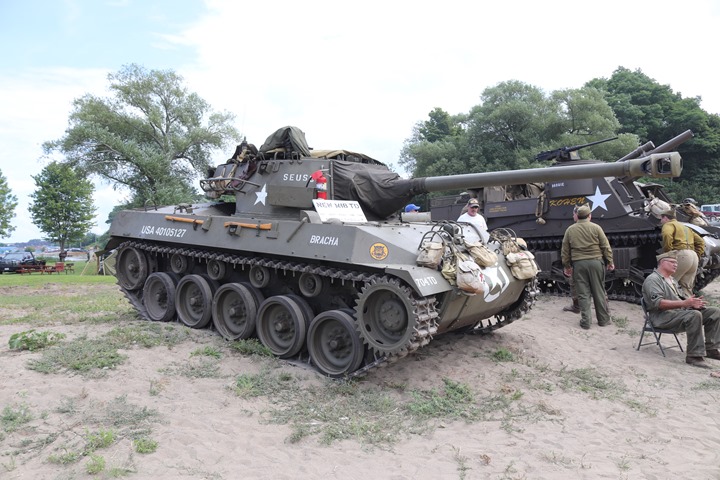
This restored M18 Hellcat shows the Motor
Wheel-built road wheels, idler wheel, and return track rollers. Author's photo.
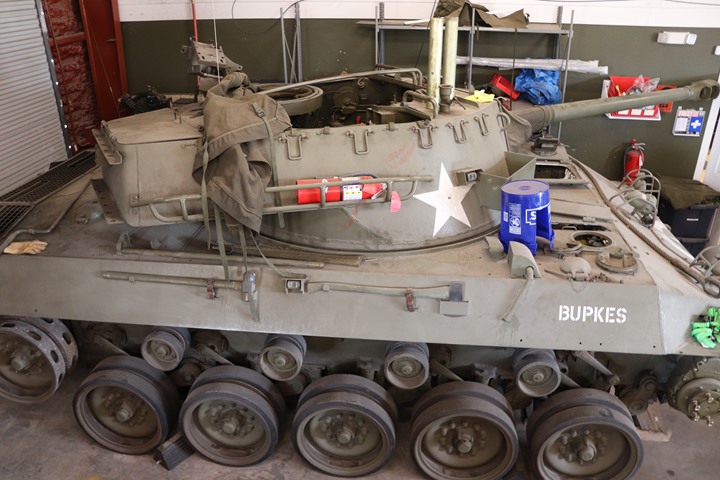
With the tracks off of this M18, it can
be seen that there are two road wheels per axle or twenty per vehicle.
There also two idler roller and track return wheels per axle. The
total number of track return rollers was sixteen per vehicle and four idler
wheels per vehicle. Motor Wheel Corporation manufactured the steel
wheel and then sent it on to another supplier to add the rubber tire. Author's photo.
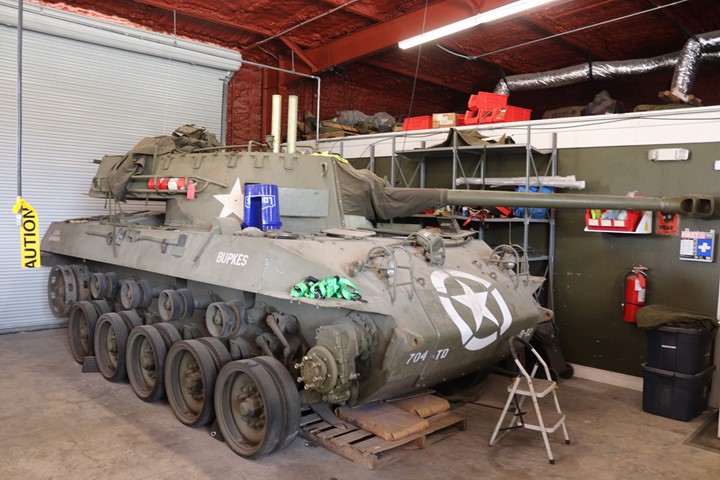
Motor Wheel produced 50,140 M18 road wheels,
40,112 track return rollers, and 10,028 idler wheels during World War
Two. Both the road wheels and the return rollers needed to be sent to a rubber
company to vulcanize the rubber tire on. All three types of wheels
were then sent to the final supplier to add the bearings. Author's
photo.
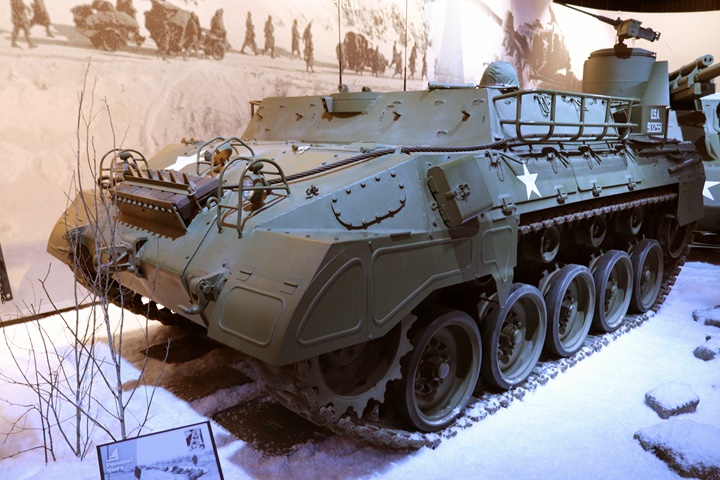
Production of the M18 was discontinued in 1944 after a short two year
production run because the 76mm main gun was not able to penetrate the
armor of German Panther and Tiger tanks as expected. Because of
this, 640 M18s had their turrets removed and the interior of the vehicle
configured as a troop carrier. This new vehicle was designated as
the M39. The M39 continued to use the same Motor Wheel
Corporation-built wheels as the M18. Author's photo.
M26 Heavy Tank Road, Idler, and Return
Track Wheels: Motor Wheel had the exclusive contract for these
components.
|
Chrysler
and Fisher Body-Built
World War Two M26 and M45 Pershing Heavy Tanks Accepted by Detroit Ordnance, US Army
The information below comes from "Summary Report of
Acceptances, Tank-Automotive Material, 1940-1945"
Published by Army Services Forces, Office, Chief of
Ordnance-Detroit, Production Division, Requirements and
Progress Branch
January 21, 1946.
Included are the number of wheels and track rollers that Motor Wheel
Corporation manufactured for this vehicle. |
|
Type |
1944 |
1945 |
Total |
| M26 - Fisher
Body |
40 |
1,689 |
1,729 |
| M26 -
Chrysler |
|
473 |
473 |
| M45 -
Chrysler |
|
185 |
185 |
| Total |
40 |
2,347 |
2,387 |
| |
|
|
|
|
Road Wheels - 24 per Vehicle |
960 |
56,328 |
57,288 |
| Idler
Wheels - 4 per Vehicle |
160 |
9,388 |
9,548 |
|
Return Track Rollers - 20 per
Vehicle |
800 |
26,940 |
27,740 |
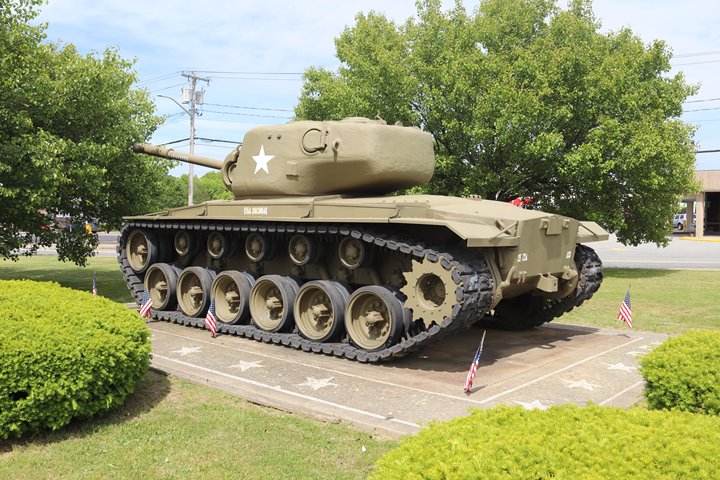
This is a Fisher Body-built M26 Pershing with Motor
Wheel Corporation-produced road wheels, idler wheels, and return track
rollers. Motor Wheel shipped the road wheels to the Kelsey-Hayes
Company which was responsible for adding the rubber tire and the
installation of the bearings and hub assembly. Author's photo.
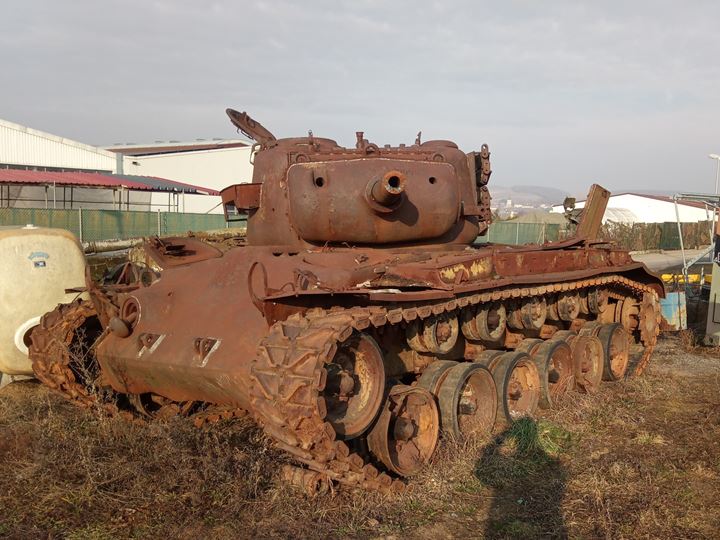
This un-restored M26 shows two Motor
Wheel-produced road wheels without the rubber tire. Author's
photo.
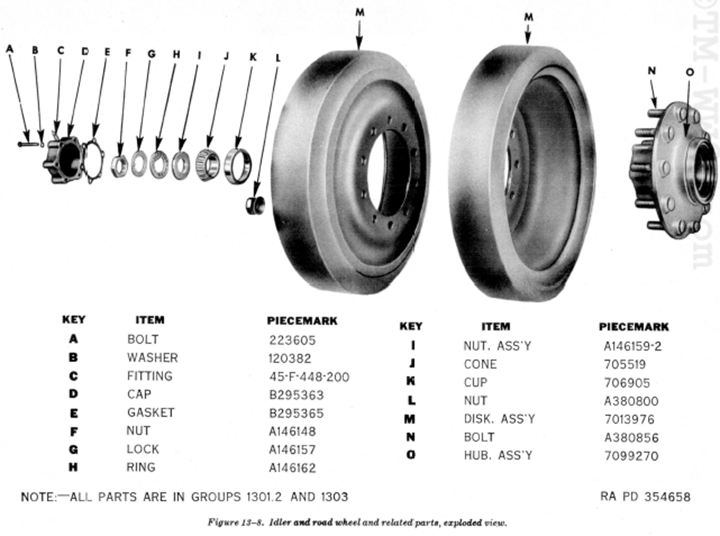
This image shows the final assembly of two
Motor Wheel wheels, or disks as described by the U.S. Army, into the
final assembly which was completed by Kelsey-Hayes.
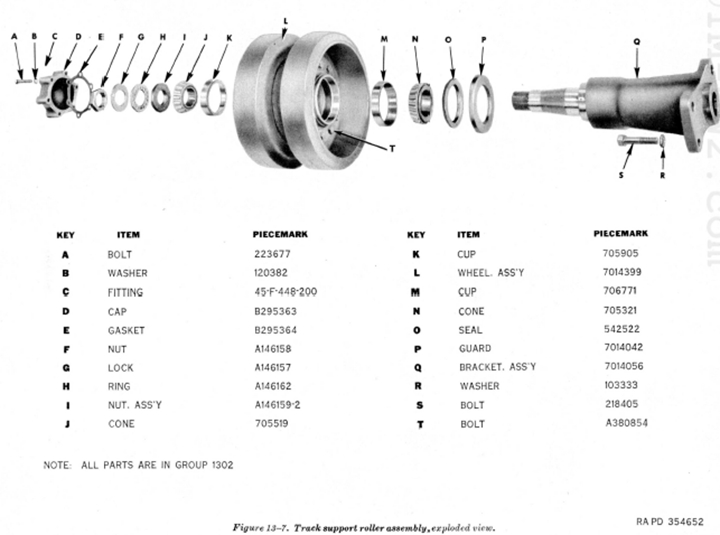
This image details the track support roller
assembly with two Motor Wheel rollers.
Landing, Vehicle, Tracked Road Wheels (LVT):
The Motor Wheel Corporation produced an undetermined number of road
wheels for the LVT series of tracked landing craft. The "Motor
Wheel News" only has one reference that the company was producing
boogie, or road wheels, for the LVTs. The article has two photos
that show two different types of LVTs. One was the type LVT
which had the prime contractor as the Food Machinery Corporation.
The Reo Motor Company in Lansing was producing boogie wheel assemblies
in its nearby plant on the south side of Lansing. Motor Wheel
could have been a supplier to Reo for the wheels.
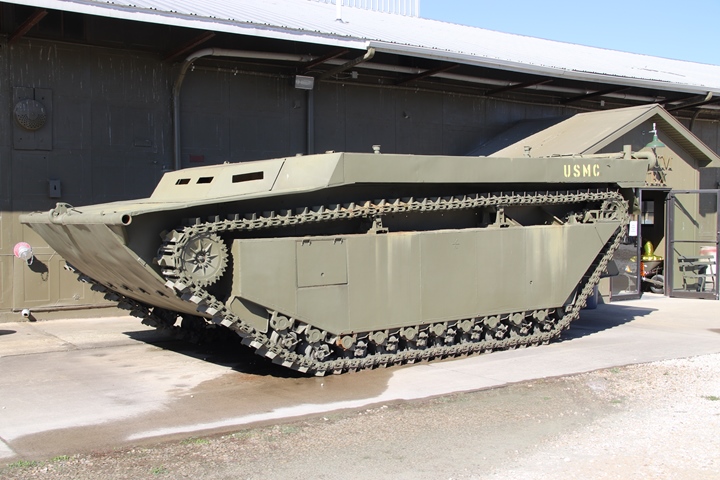
This is an LVT-4 for which the Food
Machinery Corporation was the prime contractor. Author's photo.
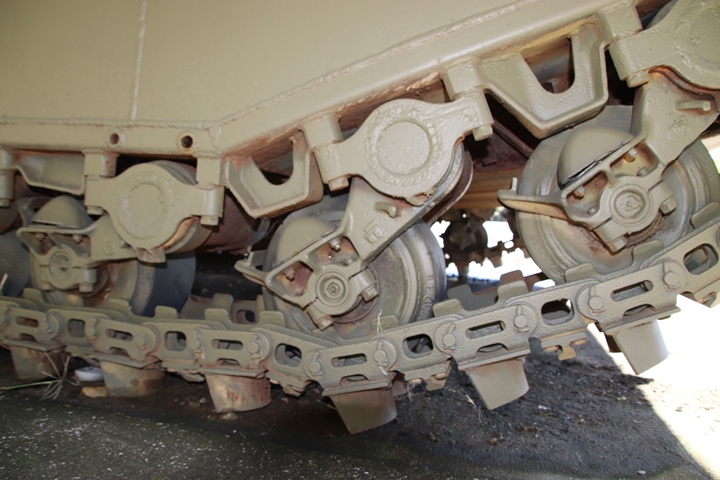
This photo shows the boogie wheels for the
LVT-4. Author's photo.
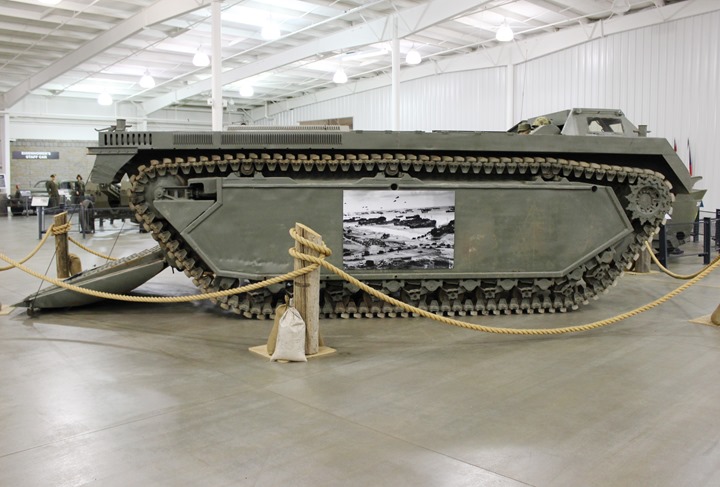
The LVT-3 was developed and built by the
Ingersoll Steel and Disc Division of Borg Warner in Kalamazoo, MI. One of the photos in the "Motor Wheel
News" article on the LVTs shows an LVT-3 landing at Okinawa in
1945. The historical record is unclear for which type of LVT Motor Wheel was
making boogie wheels. Author's photo.
Motor Vehicle and Aircraft Brake Drums:
Motor Wheel Corporation produced the rear brake drums and hub
assemblies for the GMC CCKW truck series. It also produced brake drums
for the B-17, B-24, B-29, and P-47 aircraft. All Motor Wheel
brake drums utilized castings furnished by Centrifugal Fusing of
Lansing, MI.
Motor Wheel was one of two suppliers that
supplied brake drums for the GMC CCKW series of trucks. It all
depended upon which type of axle was used in the vehicle.
Timken-Detroit Axle Company was the primary supplier of axles for the
CCKW. These were known as split axles due to the type of
differential it used. Motor Wheel supplied the rear brake drums
and hub assemblies for this type of rear axle. Timken-Detroit supplied the
front drums on these type of axles. However, the Timken-Detroit Axle
Company was not able to supply all of the axles required. Chevrolet also
supplied axles for the CCKW series trucks. These were known as
banjo axles, again due to the type of differential manufactured by
Chevrolet. These axles did not use Motor Wheel brake drums.
An estimated 50% of the CCKW series trucks
were assembled with Timken-Detroit axles. Motor Wheel Corporation
supplied an estimated 1,097,044 rear brake drums and hub
assemblies for the vehicle.
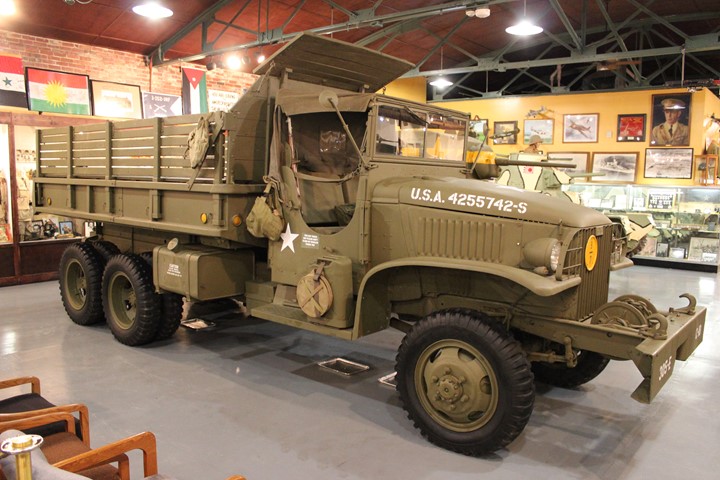
This is a pristine GMC CCKW-353 airborne
cargo-dump. All airborne cargo-dumps were equipped with Timken-Detroit split axles and Motor Wheel brake drums.
Author's photo
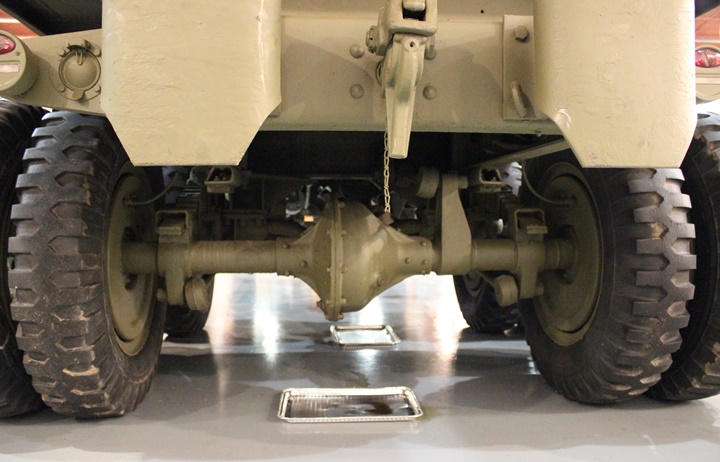
The Timken-Detroit split differential axle
with Motor Wheel brake drums.
Author's photo.
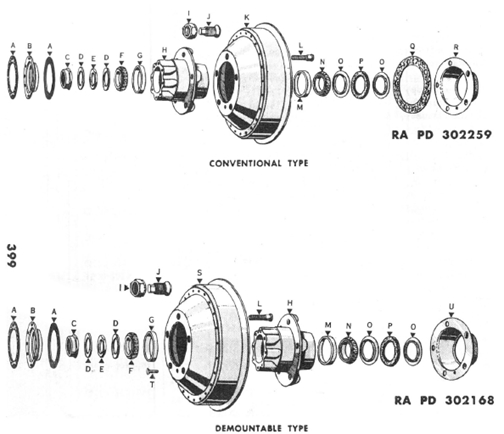
The Motor Wheel part number for the rear
conventional brake drum was 80026A. The part number for the
demountable type was 82517A.
|
Motor Wheel CCKW Truck Series
Rear Split Axle Part Numbers |
|
Part Type |
Part Number |
| Rear
conventional brake drum |
80026A |
|
Rear demountable brake drum |
82517A |
|
Rear conventional hub assembly with brake drum - left |
82004 |
|
Rear conventional hub assembly with brake drum -right |
82003 |
|
Rear demountable hub assembly with brake drum - left |
82514 |
|
Rear demountable hub assembly with brake drum - right |
82513 |
|
Rear conventional hub assembly |
82005 |
|
Rear demountable hub assembly |
82005 |
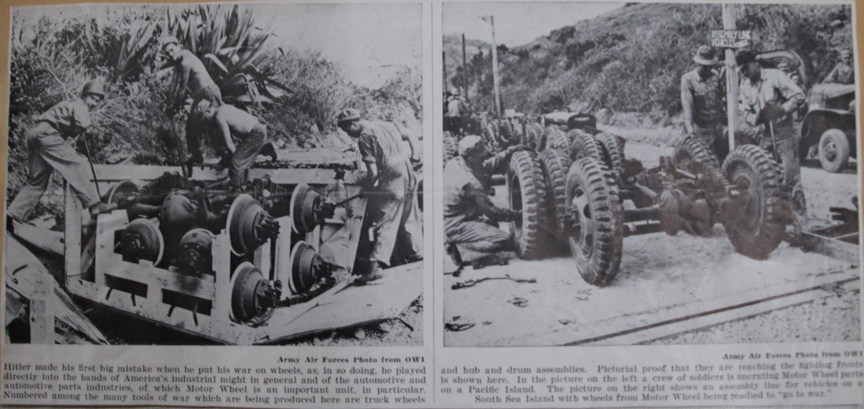
This October 1, 1943 "Motor Wheel News"
article shows truck axles being uncrated and then assembled into 6x6
trucks. These are GMC 2-1/2-ton CCKW trucks from the size of
the wheels and the split type of differential. The photos state that
not only were
the wheels built by Motor Wheel but also the hub and drum assemblies. What is
missing from the article is an exact identification of the vehicles. The newsletter editor may have found these photos
and used them as a generic example of the war products being
manufactured by the company. If so, he was lucky to have found
photos of GMC CCKW axles with split axles built by Timken-Detroit.
They could very well have been Chevrolet banjo type axles.
Maybe he knew the difference.
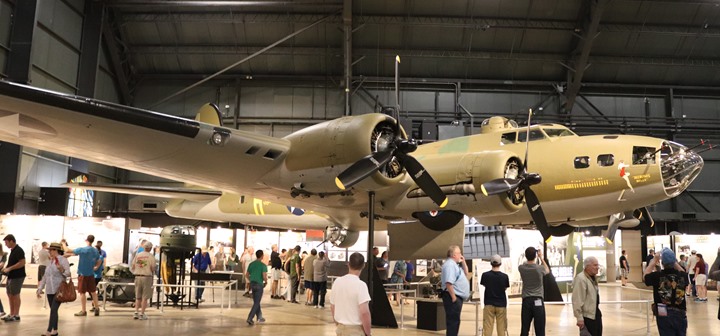
This is the B-17F Memphis Belle on May 17,
2018, 50 years to the date that she completed 25 combat missions over
Europe. This photo was taken several hours after the dedication of
the Memphis Belle at the National Museum of the United States Air Force.
The Memphis Belle, which is one of the most famous aircraft of World War
Two, came equipped with Motor Wheel brake drums. Author's photo.
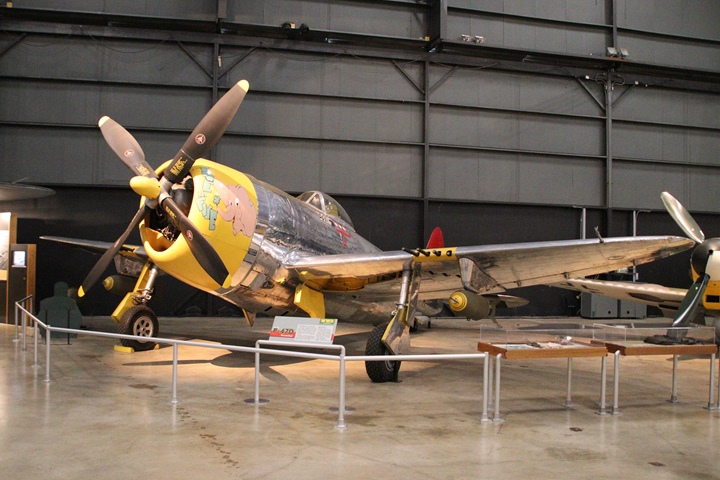
The front page of the November 1, 1942 issue
of the Motor Wheel News had photo of three P-47s in flight. The
caption underneath the photo noted that the P-47s were equipped with
parts produced by Motor Wheel. Most likely the parts were brake
drums similar to the ones the company was building for the B-17.
Author's photo.
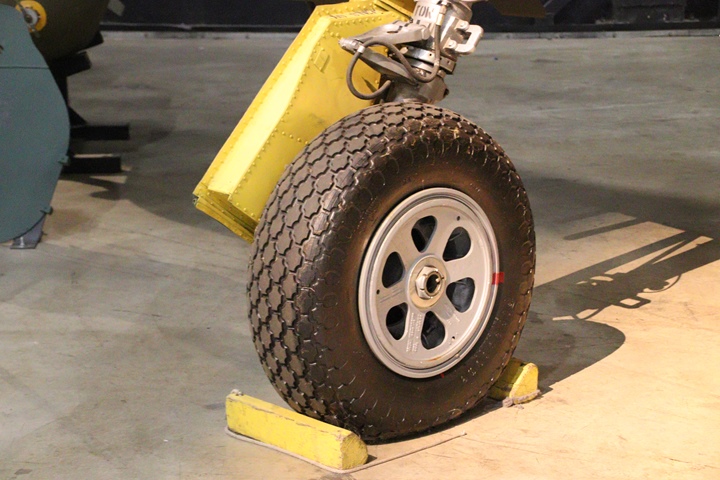
The drum would have fit in each of the
wheels of the main landing gear. Author's photo.
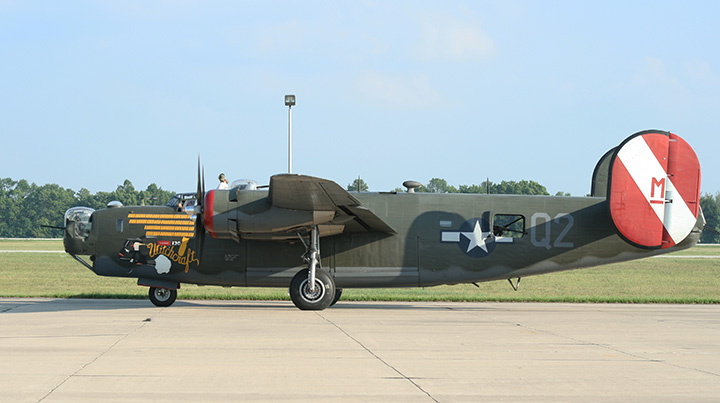
The "Motor Wheel News" notes that the
company made parts that were on the B-24. It has to be assumed
these were brake drums. The B-24 was the most widely produced
American heavy bomber of World War Two with 18,493 built. Author's
photo.
The B-29 Program: Motor Wheel was
the exclusive supplier of both the brake drums and propeller domes for
the B-29 Superfortress.
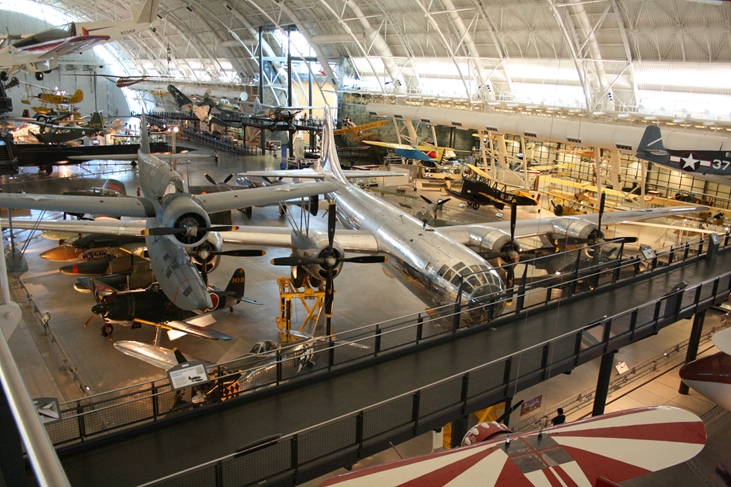
The B-29 Enola Gay was equipped with brake
drums and propeller dome built by the Motor Wheel Corporation in
Lansing, MI. Author's photo.
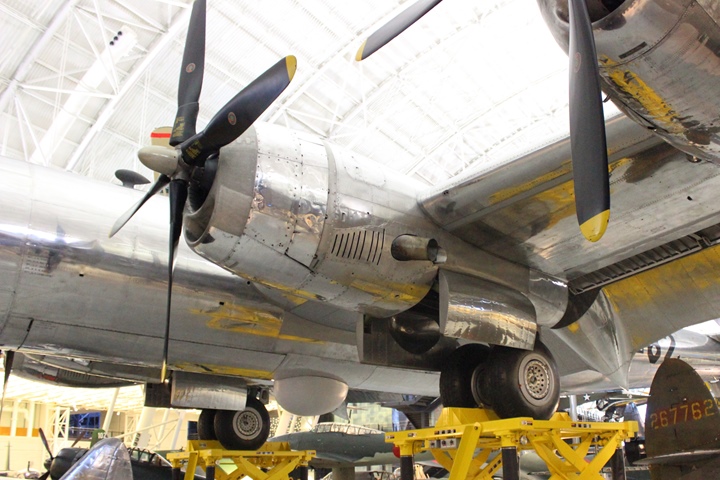
Author's photo.
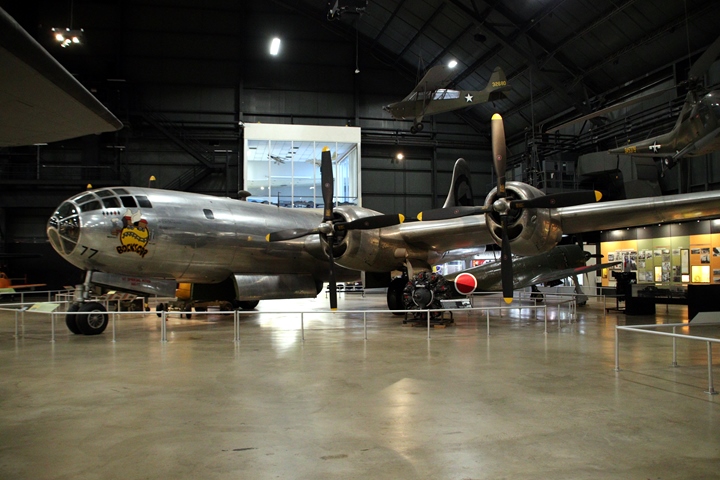
This the B-29 Bockscar at the National
Museum of the United States Air Force in Dayton, OH. It is one of
3,763 B-29s were built by four different companies during World War Two.
Author's photo.
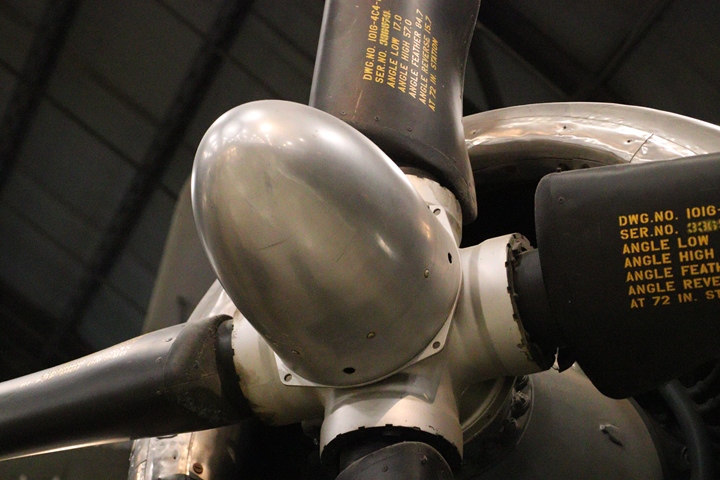
A close-up view of one of the Motor
Wheel-built propeller domes on Bockscar. Motor Wheel was the
exclusive manufacturer of the propeller domes as described in the November
1944
edition of Motor Wheel News and supplied at least 15,052 propeller domes
plus spare units for the war effort. Author's photo.
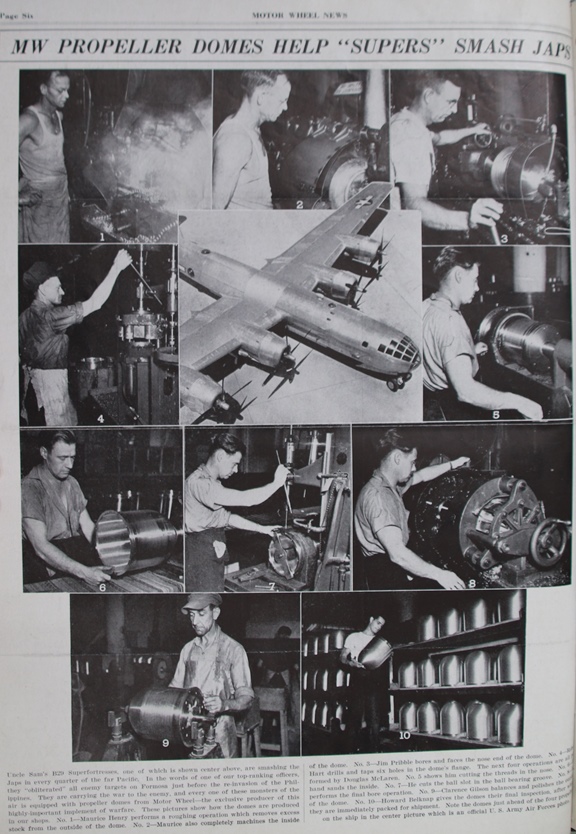

The above page from the Motor Wheel News
shows parts of the manufacturing process for the propeller domes.
Note that none of the workers were wearing safety glasses.
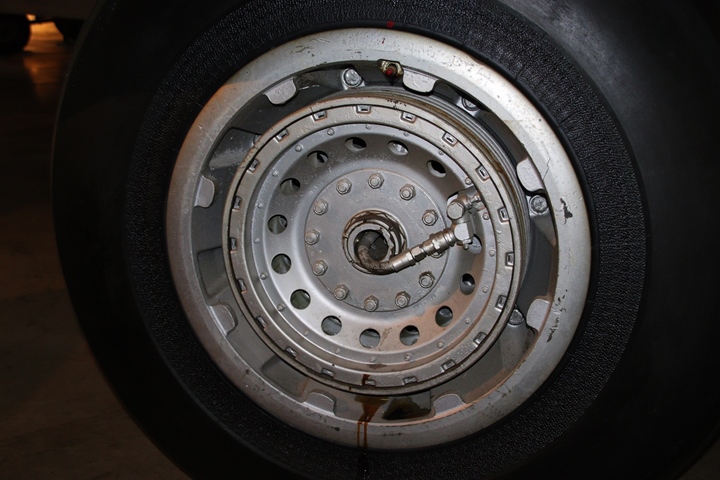
Motor Wheel also made brake drums for the B-29 bomber. This is the outside port wheel and tire for
Bockscar. The ridges on the outer diameter of the Motor Wheel brake drum can
actually be seen from the 12 o'clock to 2 o'clock position. The
drawings below show the ridges in more detail.
Author's photo.
Motor Wheel was most likely the exclusive supplier
for the B-29 brake drums. While this was not specifically
stated in any edition of the "Motor Wheel News," when the workers of its
casting supplier went on strike in 1945, brake production for the B-29
came to a halt. Based on this, Motor Wheel Corporation would have
produced a minimum of 30,104 plus brake drums plus spares. Each
B-29 had two sets of brakes on its four main wheels. Brake
drums on the B-29 were a high maintenance
item and there would need to be a constant flow of spare parts for
replacement. Motor Wheel was a sub-contractor to the company that
supplied the brake assembly for the aircraft.
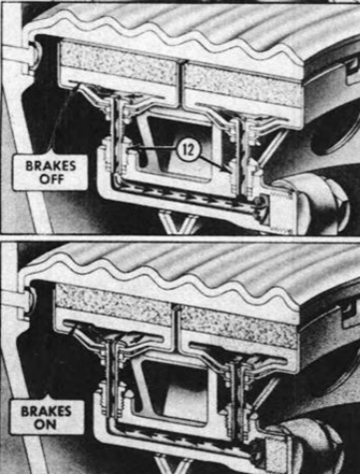
This image shows that the brake drums were actually made of two pieces.
It also shows the ridges in the outer diameter. The purpose for
the ridges may have been to give the brakes more surface area to assist
in their cooling.
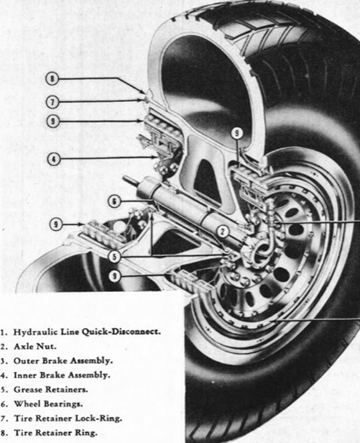
This image shows the two sets of brakes on
the B-29 main landing gear.
Shells and Rockets: Motor Wheel
Corporation produced several types of projectiles, shell casings, and
rockets during World War Two.
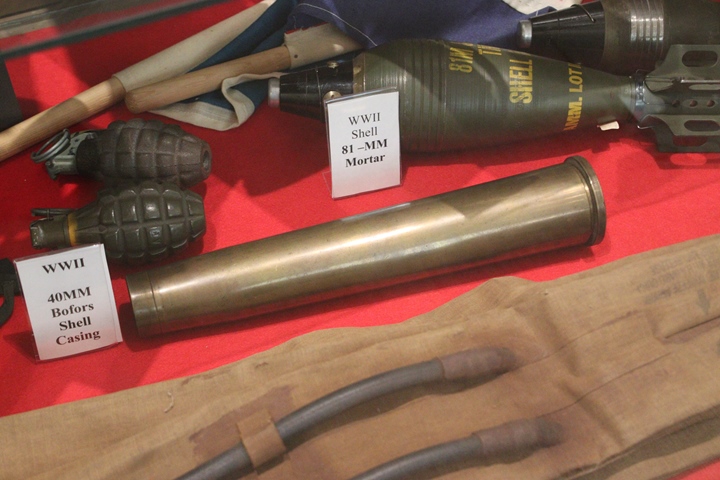
The U.S. Navy awarded Motor Wheel
Corporation its first Army-Navy "E" award in June 1942 for the
production of one million 40mm shell casings, twice the amount the Navy
had expected in the same time period. Author's photo.
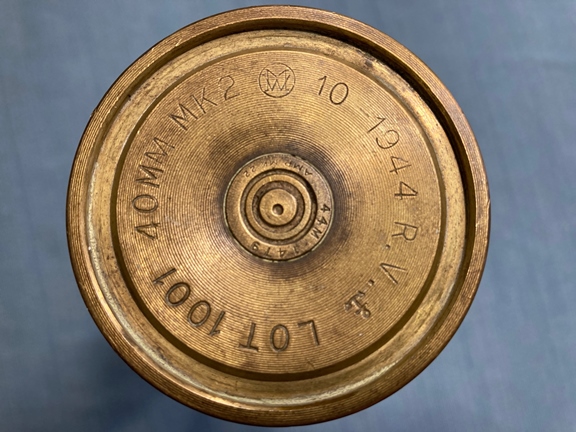
This is a 40mm shell casing with the Motor
Wheel insignia shown at the top of the photo. This was lot number
1001 dated October 1944. Photo courtesy of Superstar added
11-6-2023.
The "Motor Wheel News" indicates that the
company signed a contract with the U.S. Navy in late 1941 for the
manufacture of 40mm shell casings. Five months later, in March 1942,
it was announced that Motor Wheel had produced a million shell casings.
This was a very short time period to produce this volume as there had to
be time to make the tools and set up the equipment. This was a
significant accomplishment on the part of Motor Wheel.
Assuming production began in December 1941,
this would have been an average rate of 333,333 shell casings per month.
No doubt there was a ramp up time with more casings being produced
in early March 1942 than at the end of 1941. However, if one uses
the 333,333 per month production rate for the remaining 40 months of
World War Two, the Motor Wheel Corporation manufactured at least
13,333,320 40mm shell casings for the U.S. Navy. The company no
doubt produced more than this amount, as it added equipment and became
more experienced in the manufacturing process.
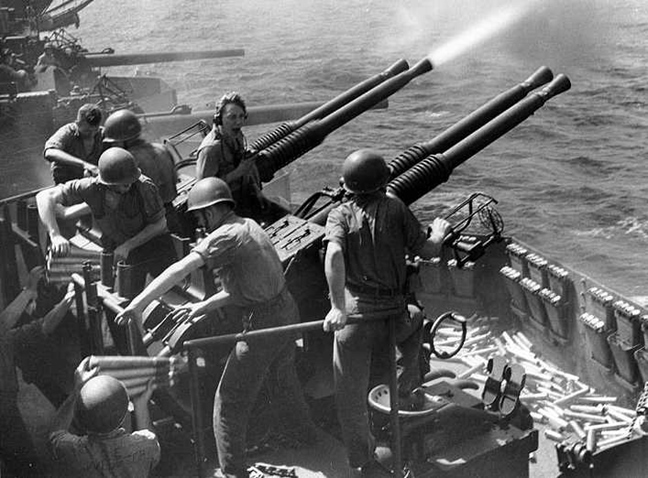
This remotely aimed quad-mount 40mm
anti-aircraft gun on the U.S.S. Hornet CV-12 is expending 40mm
ammunition at an impressive rate in fighting off attacks by Japanese
aircraft in 1945. Ammunition loaders are feeding in four-round clips
as fast as they can be handed to them. Empty shell casings,
some of them possibly made by the Motor Wheel Corporation, litter the
deck. Each barrel for short bursts could fire at a rate of 120
rounds per minute. This scene played out on every 40mm on every
U.S. Navy ship in the Pacific Ocean when under attack. The U.S.
Navy needed ever 40mm shell casing it could produce!
Motor Wheel Corporation was one of the
initial contractors for the U.S. Navy's 40mm program. Production
of the actual shells began in March 1942 with 15,000 rounds produced.
At the beginning of the program, Motor Wheel was producing shell casings
faster than the ammunition factories could turn out the actual rounds.
Production sharply ramped up; and by the end of the war, the U.S. Navy had
purchased a total of 191,559,000 rounds of 40mm ammunition.
The 40mm Bofors anti-aircraft gun is one of
the most iconic weapons of World War Two. The U.S. Navy
procured at least 39,200 40mm Bofors anti-aircraft guns that were
mounted on every type of ship the Navy had during the war.
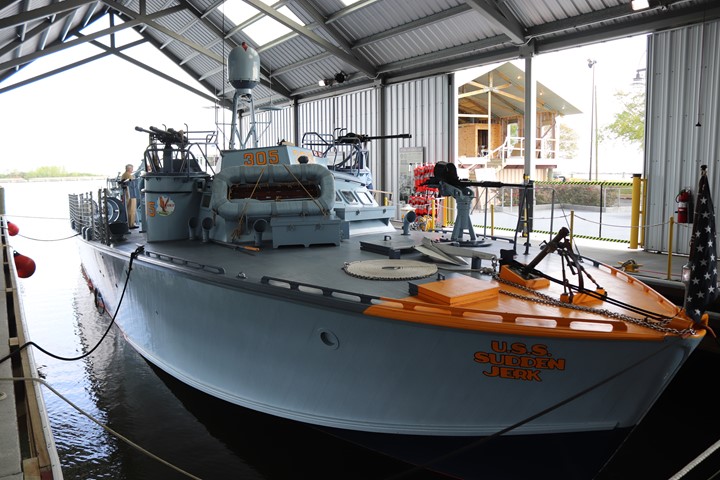
One of the smallest craft that mounted 40mm
Bofors was the PT boat. This is PT-305 which was built by Higgins
Industries. Author's photo.
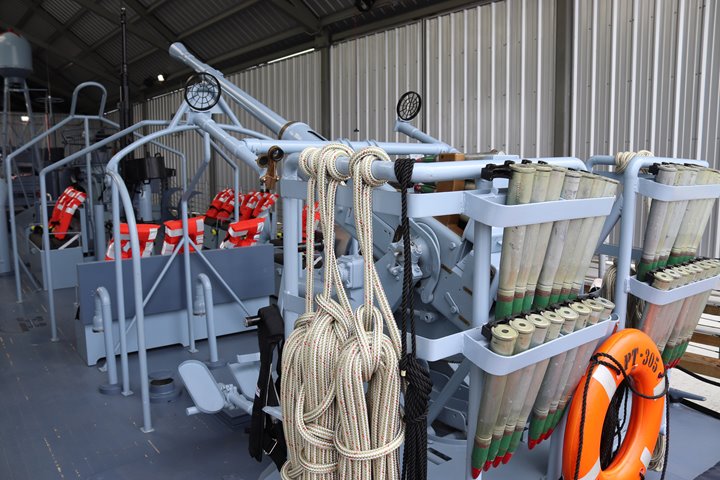
Ready ammunition containers behind the
40mm Bofors on PT-305 show the size of the shell casings that Motor
Wheel produced during World War Two. Author's photo.
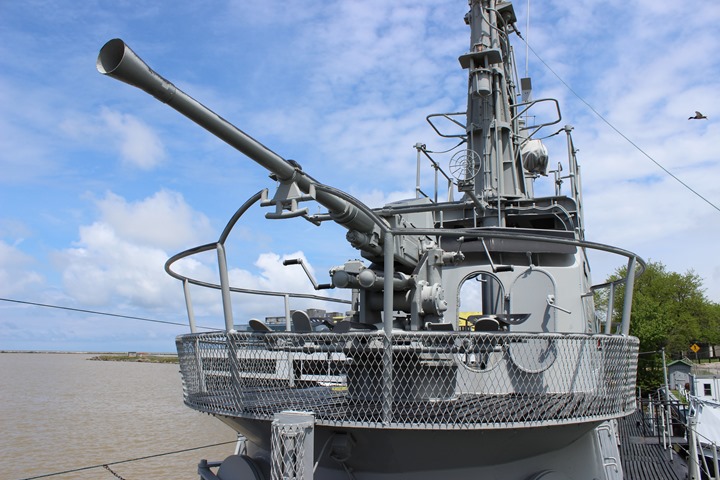
The U.S. Navy purchased over 10,000 single
mount 40mm Bofors guns that used Motor Wheel shell casings in their
ammunition. This single mount is on the USS Cod. Author's
photo.
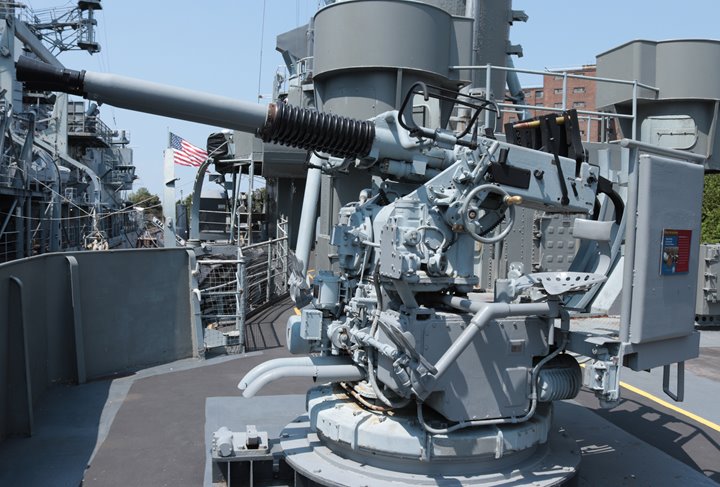
This dual mount 40mm anti-aircraft gun is one of nearly 10,000 that
defended Navy ships from aircraft attacks during World War Two.
During Japanese suicide attacks on American ships in the Pacific,
weapons like these used significant amounts of ammunition with Motor Wheel-shell
casings. This example is on the USS Sullivans. Author's
photo.
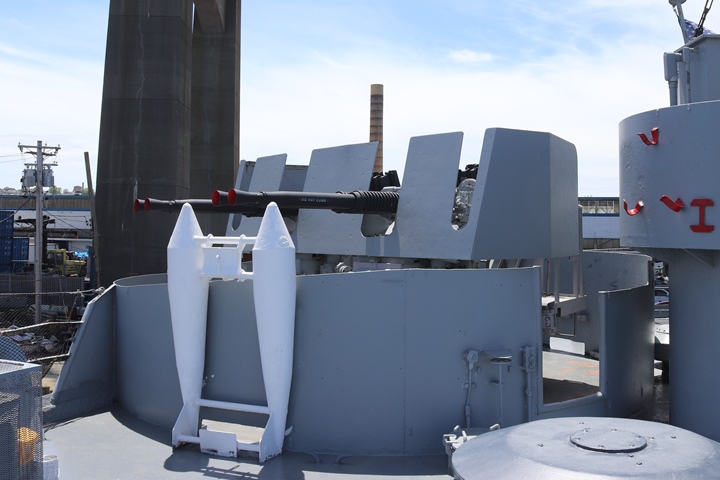
The battleship USS Massachusetts bristled
with 40mm anti-aircraft guns as did every other battleship during World
War Two. The battleships were large enough to mount the large quad
mounts on the ship. The 40mm Bofors had a rate of fire of 120
rounds per minute. For short bursts, a quad mount like this one could
fire at a rate 480 per minute. The
U.S. Navy needed every one of the over 13million 40mm shell casings
Motor Wheel made during the war. Author's photo.
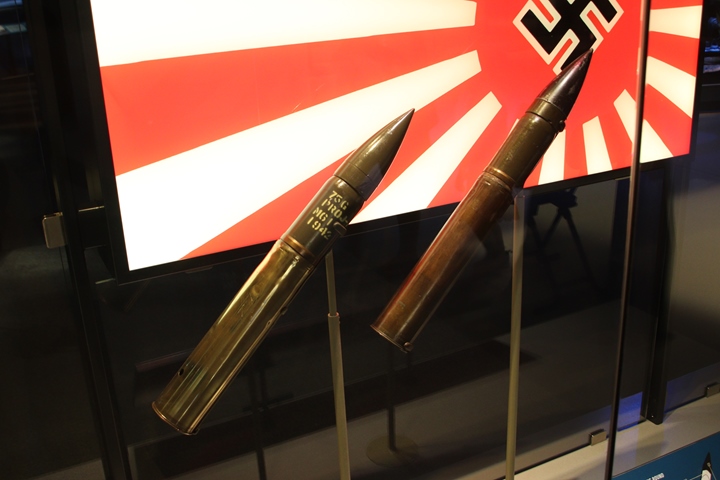
One of Motor Wheel's first contracts in
November 1941 was for 400,000
75mm semi-armor piercing shell projectiles. Shown here are two
armor piercing shells which are very similar to the semi-armor piercing
type. Author's photo.
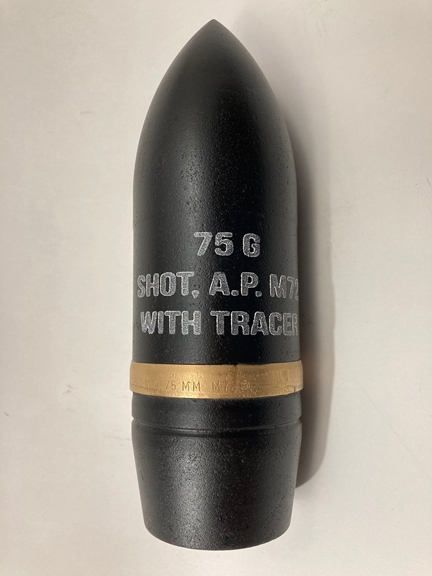
How cool is this? This photo is of a Motor Wheel Corporation M72
armor piercing shot with tracer that still exists. Image courtesy
of www.ww2ammo.com
added 7-31-2022.
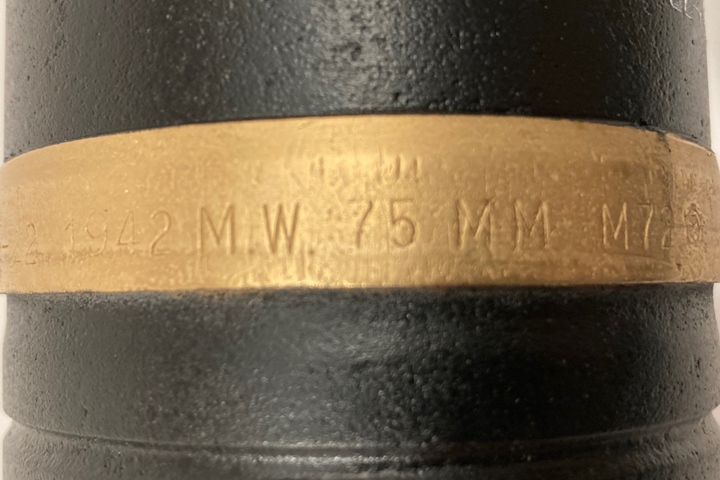
This image shows the "M.W." designating
Motor Wheel and a date of 1942. Image courtesy of
www.ww2ammo.com
added 7-31-2022.
Mark 10 7.2 Inch Rockets (Hedgehogs):
Motor Wheel built the Mark 10 rocket which was used on destroyers
and destroyer escorts in anti-submarine warfare. Motor Wheel
manufactured the head, tail, fins, and shrouds. They were then sent to a
Naval munitions plant, where either 30 pounds of TNT or 35 pounds of Torpex were added to the head. A small rocket motor was added to
the tail, which gave the weapon a range of 250-280 yards when
it was fired over the bow of the ship.
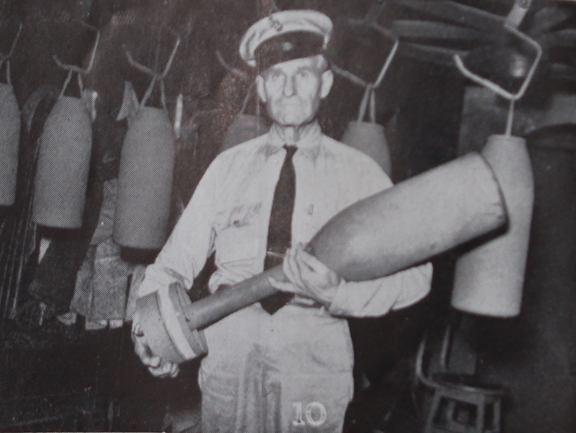
This U.S. Navy inspector is holding a Mark
10 rocket, as rocket heads move on a conveyor through the paint
shop in the background. Production of the completed 7.2 inch began
for the U.S. Navy in July 1942 with 2,000 manufactured. By the end
of production in February 1945, 509,000 had been made. This was a very
important weapon in the war against the U-boat.
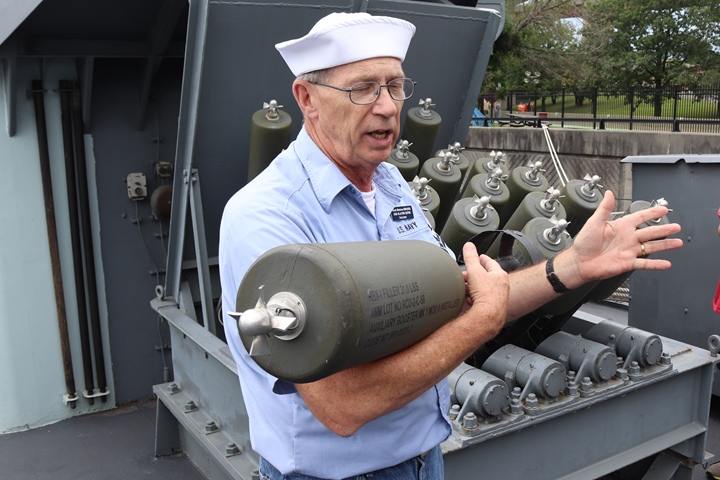
I could not have planned this photo any
better! This photo was taken five years before the writing of this
webpage on the Motor Wheel Corporation, but the docent on the USS Slater
is holding the Mark 10 rocket in a very similar pose to the U.S. Navy inspector in the previous
photo. The photo reveals that the head of the weapon was assembled
from three pieces. The weld line can be seen going around the
radius of the head where the top plate and the main cylinder are joined
together. The spinner on the fuse would not activate the weapon
until it had traveled far enough to keep it from exploding by accident
while still over the ship. The Reo Motor Car Company on the south
side of Lansing could very well have manufactured the spinner and
detonator assembly, as it was a large manufacturer of this product. Author's photo.
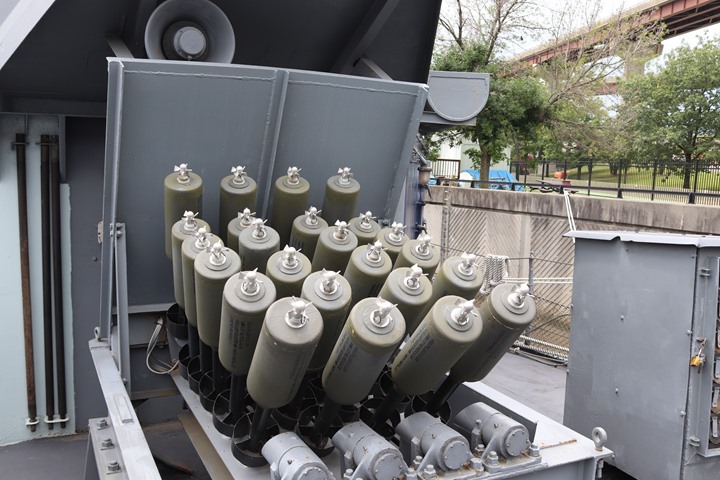
Twenty-four Mark 10s were mounted in the
launcher. Each rocket tail was mounted on a long cylinder
called a spigot. The spigots were oriented so that when all 24
projectors were fired in rapid sequence, they fell in an elliptical
pattern 140 by 120 feet, 250-280 yards in front of the moving ship.
The Mark 10 projectors would only detonate on contact with an enemy
submarine. This was unlike the depth charges that were set to go
off at a certain depth. Author's photo.
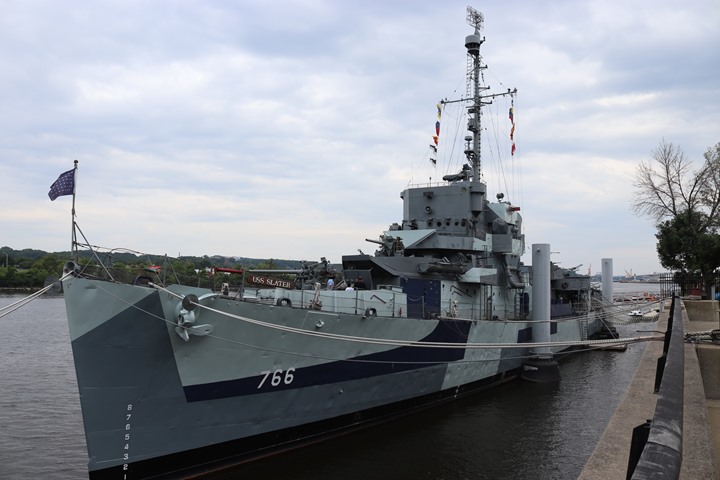
The USS Slater is the only Cannon Class
Destroyer Escort on display in the world. It is located on the
Hudson River in downtown Albany, NY. Author's photo.
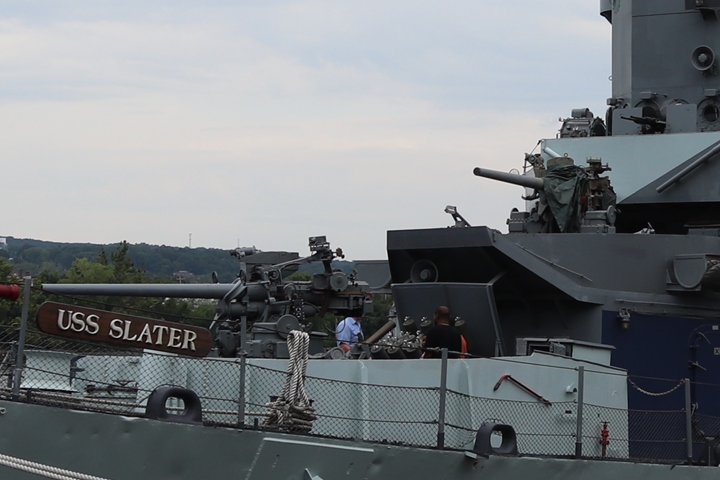
The Mark 10 rockets were deployed from
between the number one and number two gun positions. Author's
photo.
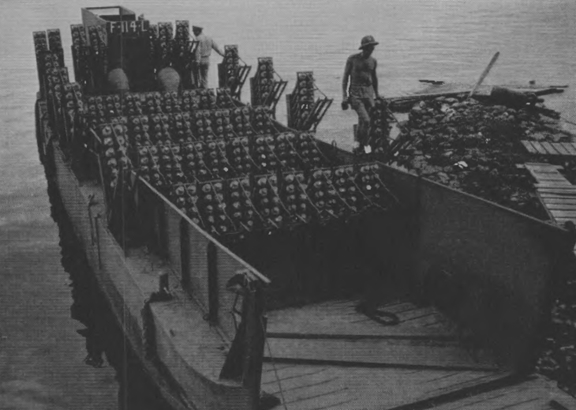
The "Motor Wheel News" makes note that its
rockets were used for shore bombardment during amphibious landings by
American forces. The Mark 10 was modified and with a 3.5-inch
rocket motor and achieved a range of 1,200 yards. These were used
to destroy mines and obstacles in the shallow water at the shoreline.
7.2-inch rockets like those built by Motor Wheel were first used
in mid-1944 and launched from modified LCMs.
The U.S. Army also used a version of the Mark
10 rocket for use as demolition charges fired at enemy positions.
The Army designated it as the T37, which was fired from twenty round
launchers mounted on Sherman tanks. Motor Wheel may have also
produced this weapon for the U.S. Army. However, the historical
record is unclear on this point.
Torpedo Fuel Flasks: Like the
shells, projectiles, and rockets described in the previous section,
Motor Wheel Corporation also built a product for torpedoes that was
totally foreign to its normal civilian product line. Like many
other companies in the United States during World War Two, Motor Wheel
was able to use its engineering and manufacturing capabilities to
produce totally different products for the war effort.
Most likely Motor Wheel built the torpedo fuel
flasks for the Pontiac Motor Division of General Motors in nearby
Pontiac, MI. Pontiac produced 4,526 Mark XIII aerial torpedoes for
the U.S. Navy. International Harvester built another 763 Mark XIII
aerial torpedoes at its McCormick Works in Chicago, IL. It would
have made sense for Motor Wheel to supply both nearby companies with the
same type of part. This would have made a total of 5,289 Mark
XIII torpedo fuel flasks. Other types of torpedoes for surface ships
and submarines along with the Mark XIII were also built by the Amertorp
Corporation in Forest Park, IL, a suburb of Chicago, IL. It
produced a total of 8,391 torpedoes. If Motor Wheel produced fuel
flasks for these three companies, it would have manufactured 13,680 of
the components. The other torpedo manufacturing plants were on the
east coast which would probably have had different suppliers for the
product. In total, 57,653 torpedoes of all types were produced
during World War Two.
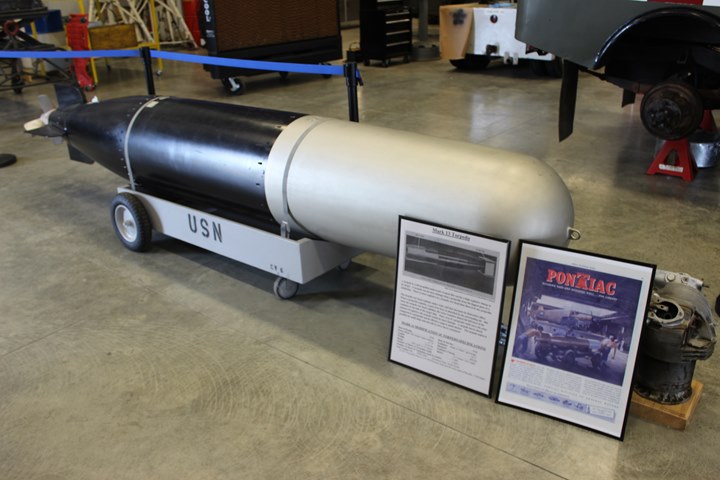
The Mark XIII aircraft torpedo. The
thirteen-foot long weapon consisted of 1,225 assemblies of 5,222
individual parts. The gyro, which guided the weapon to its target,
turned at 9,000 rpms. It had a diameter of
22.5 inches and weighed 2,216 pounds, of which 600 pounds was the Torpex
explosive. The internal steam turbine propelled the Mark XIII at 33 knots
for a maximum range of 6,300 yards. The Naval Torpedo Section, Amertorp
Corporation, Pontiac, and International Harvester produced the Mark XIII
during World War Two. The four companies built 17,000 torpedoes.
1,500 were used in combat. Author's photo.
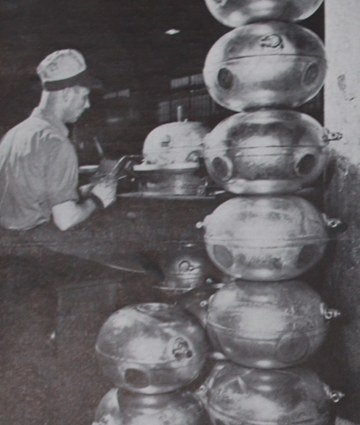
Motor Wheel was contracted during World War
Two to manufacture brass fuel flasks for torpedoes used by both
U.S. Navy submarines and torpedo bombers. This
"Motor Wheel News" photo shows the flasks being assembled from two separate
stamped pieces during World War Two. Note the brass fittings
on the sides of the flasks in the photo. Author's photo.
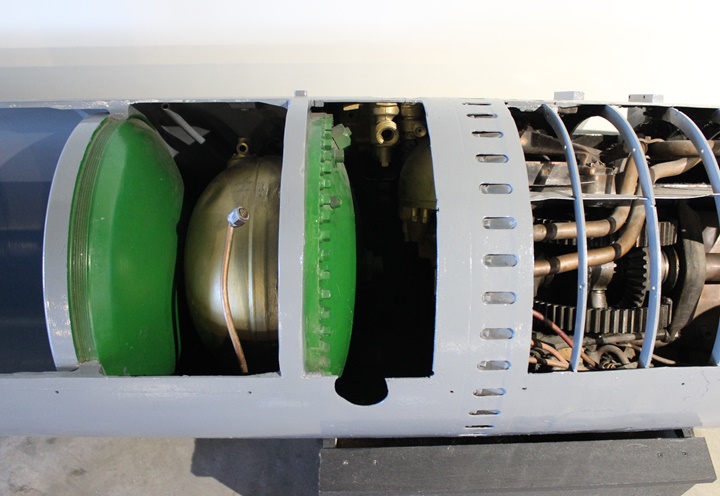
The Motor Wheel-built brass fuel flask can be seen in this cutaway of a
submarine type torpedo. The brass fitting can be seen at the top
of the flask. Author's photo.
The Motor Wheel Corporation Plants:
The company had a large complex of several manufacturing plants on the
north side of Lansing bounded from south to north by East Saginaw Street
to McKinley Street. The western boundary was Larch Street. I
lived on the south side of Lansing and was only vaguely aware of the
Motor Wheel plants. I was most aware of the large plant just east
of Larch Street which was visible as I traveled north out of Lansing to
Camp Grayling.
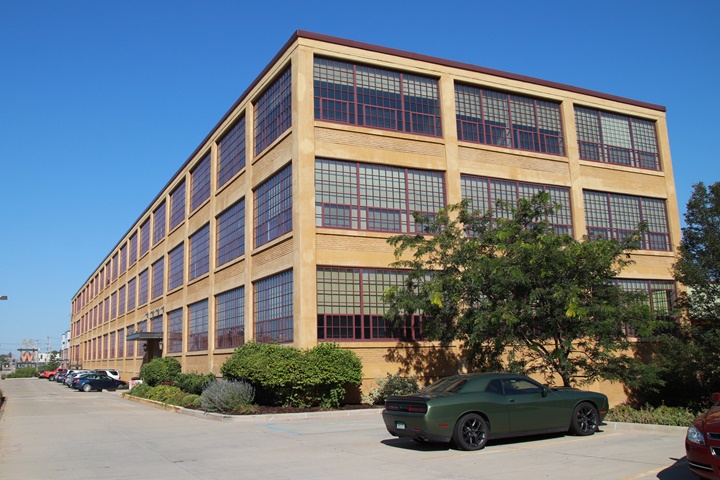
This is the former the corporate offices of
the Motor Wheel Corporation. During World War Two, the address was
716 East Saginaw Street. Until I started researching the company,
I was unaware of this plant. While I lived in Lansing, I should
have had occasion to drive by this location and notice it. The
reason I probably did not notice this building is that in 1961, Motor
Wheel moved its headquarters to Plant 2 on Larch Street. It
also then demolished the large factory complex at this location.
It is unknown why this particular building was saved. By the time I
would have driven by, there would have been no "Motor Wheel" sign on the
building nor large factory complex to look at.
In any case, this is an elegant looking
structure which today has been repurposed into the Motor Wheel Lofts
with a current address of 707 Prudden Street. Originally, this
structure was the factory for the Prudden Wheel Company, making this
building over 100 years old. This building is L-shaped and is the
only building of the factory complex still standing. It is
listed on the National Register of Historic Places as the Prudden Wheel
Company Building. The author's photo is looking west down the
south side of the building.
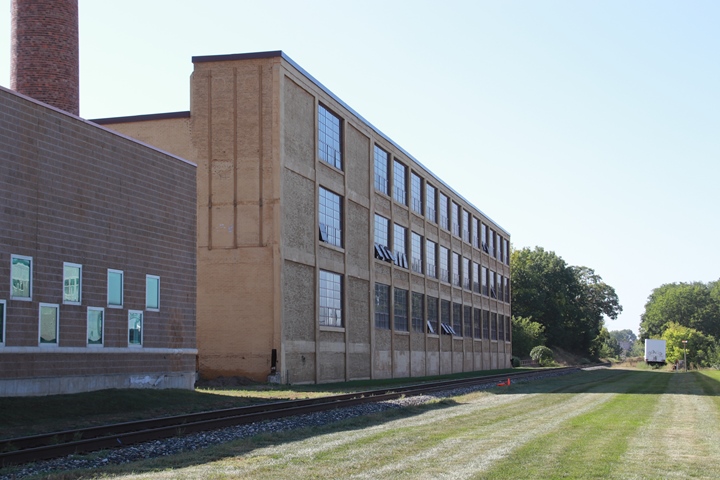
This is the west side of the structure.
During World War Two there were four sets of railroad tracks in this
area. The building in the left portion of the photo is a new
structure that replaced the former razed factory buildings.
Author's photo.
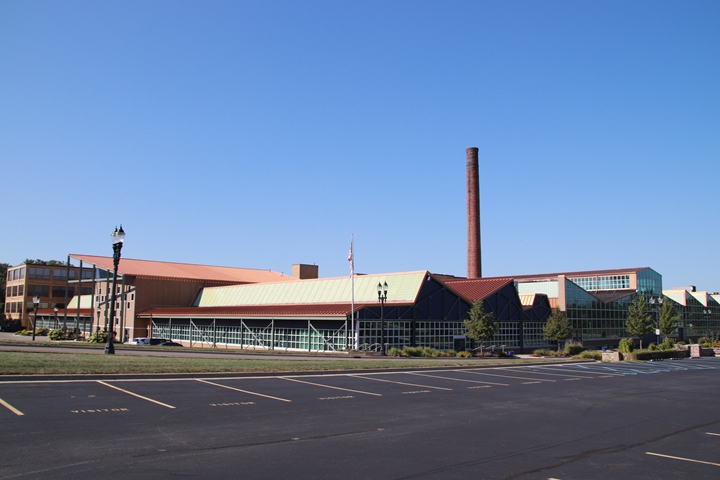
This photo is looking northwest at the
repurposed former Motor Wheel corporate offices and factory complex.
The smoke stack has the name "Prudden' on it. Author's photo.
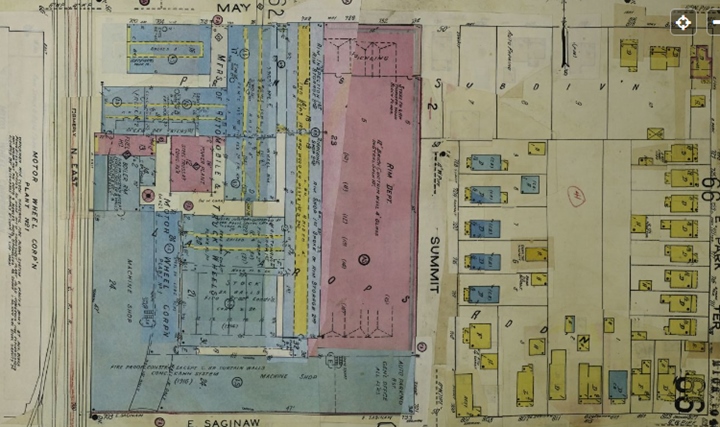
This Sanborn map shows the complex in 1951. Today Summit Street is
Prudden Street. As the current Google Maps satellite image below
confirms, most of the original structure was razed, with only the
L-shaped original building still standing. A comparison of the two
images shows that where the rim department used to be in 1951 is now a
parking lot. The east end of the L-shaped building was a parking
garage and offices. It no longer exists either.
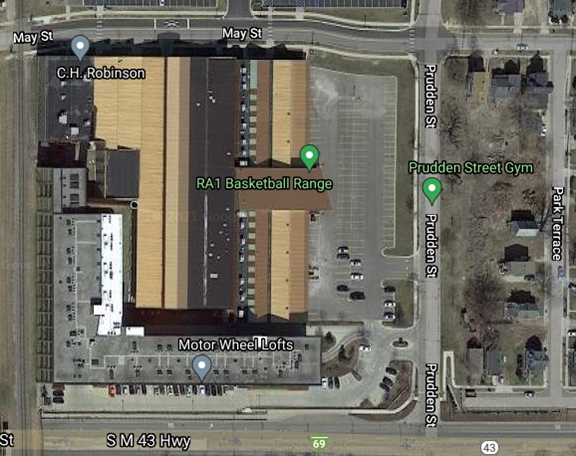
Note that May Street is the northern boundary
to this facility. Satellite image courtesy of Google Maps.
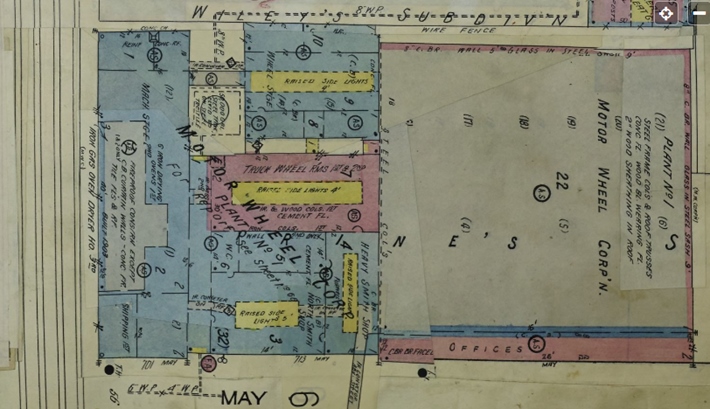
This Sanborn map shows that Motor Wheel
Corporation Plant No. 1 was directly to the north of the Saginaw Street
plant. It was also razed in 1961 and today is a parking lot.
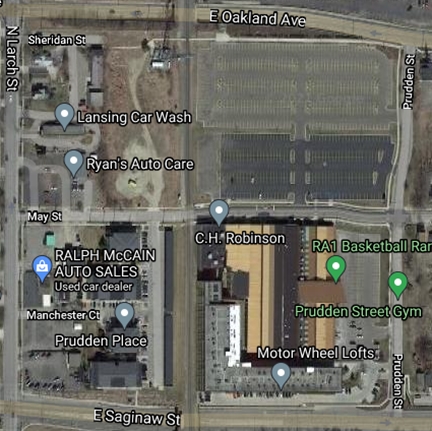
This current satellite image shows the
entire former two Motor Wheel plant locations as they are today.
Satellite image courtesy of Google Maps.
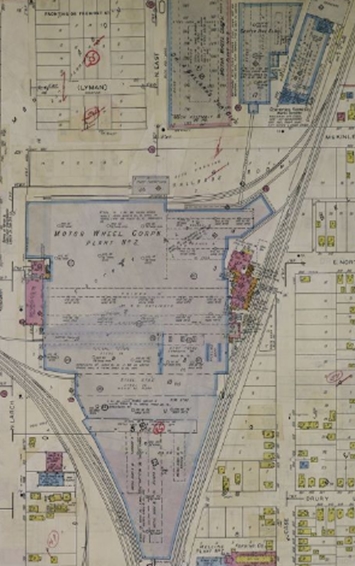
This is the Motor Wheel complex I remember
on North Larch Street, which was the western boundary to the facility.
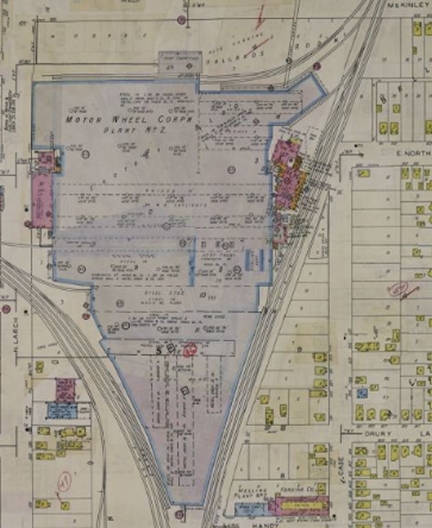
McKinley Street was the northern boundary to
Motor Wheel plant 2.
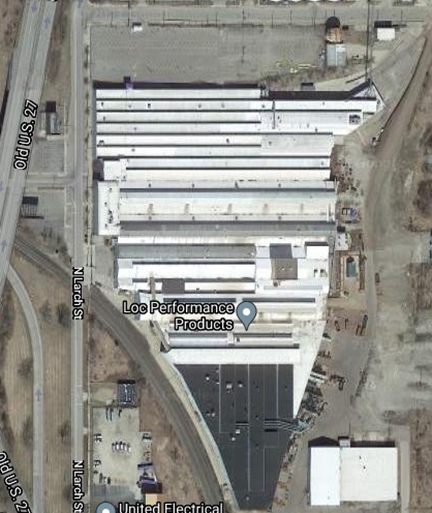
The former Motor Wheel plant that I remember still exists. In the
1970s I would see it from the U.S. 27 overpass each summer as I went to
and from Camp Grayling in northern lower Michigan. Satellite image
courtesy of Google Maps.
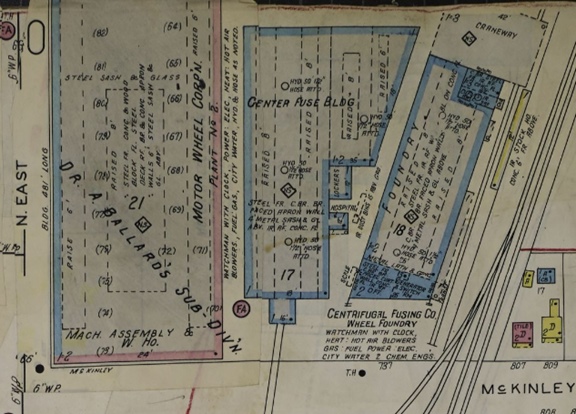
Centrifugal Fusing Company was on the north
side of McKinley Street. The company used the centrifugal casting
method to make truck
and aircraft brake castings for Motor Wheel during World War Two.
Directly to the west of Centrifugal Fusing was a Motor Wheel plant.
In 1937, Motor Wheel built the two plants and then leased them to
Centrifugal Fusing in order to have its supply of brake castings next to
the Motor Wheel complex.
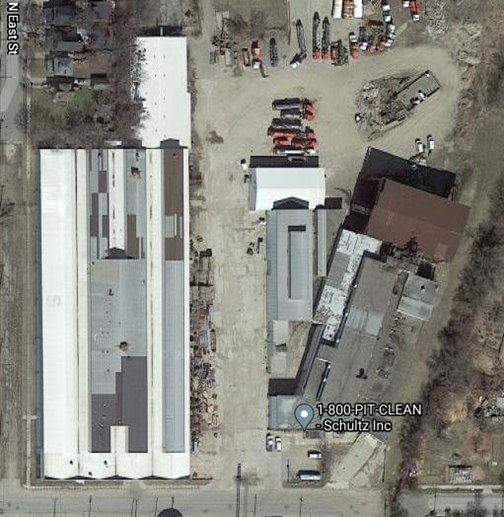
The former Motor Wheel and Centrifugal
Fusing factory complex still exists. The railroad tracks that were
the eastern boundary of the complex have been removed. McKinley
Street is now blocked where the railroad tracks used to be, and McKinley Street in front of the complex is now private property.
In 1984, Goodyear, the owner of Motor Wheel at the time, spun off the
centrifugal casting operation and the associated machining operation
into another company that moved the operations to Chattanooga, TN.
Today that new company continues the name of "Motor Wheel."
Satellite image courtesy of Google Maps.
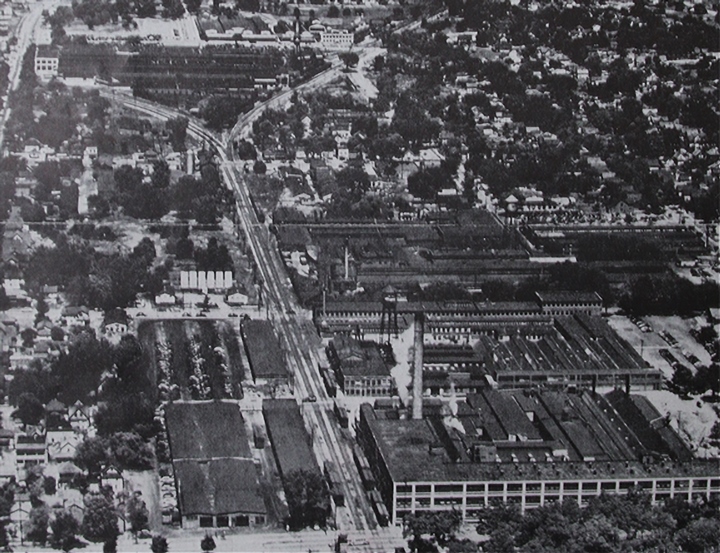
This 1945 aerial photo shows the Motor Wheel
Corporation looking north. Image added 12-25-2021.
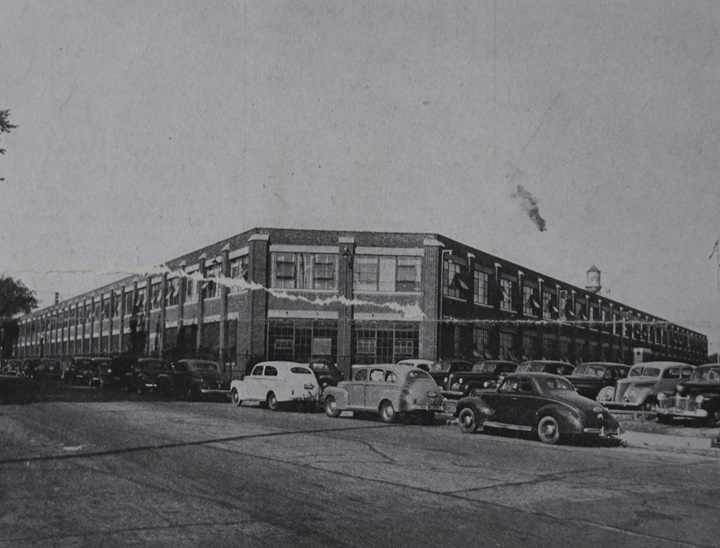
In December 1945 Motor Wheel purchased this
factory at the corner of South Washington Avenue and West Mount Hope
Avenue in Lansing, MI. The plant was purchased from the
Reconstruction Finance Corporation. During World War Two
Nash-Kelvinator built aircraft propellers in this factory. Prior
to World War Two, Motor
Wheel Corporation had developed a furnace it
marketed under the name "Duo-Therm." After World War Two, this
factory was dedicated to building furnaces. This plant was in my
neighborhood, and I remember a big Motor Wheel Corporation sign on the
top of this factory. By 1961, Motor Wheel had vacated this
building, and it was the location for the first large discount store in
Lansing. Apparently, the Duo-Therm business proved not to be as
profitable for the company as expected.
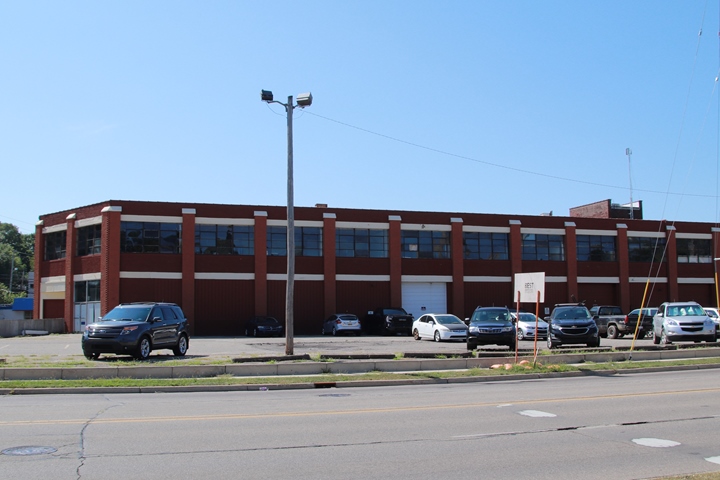
This is the plant today. During World
War Two, my grandfather worked in this plant supervising mostly women
workers in the propeller balancing department.
Author's photo. |
























































































